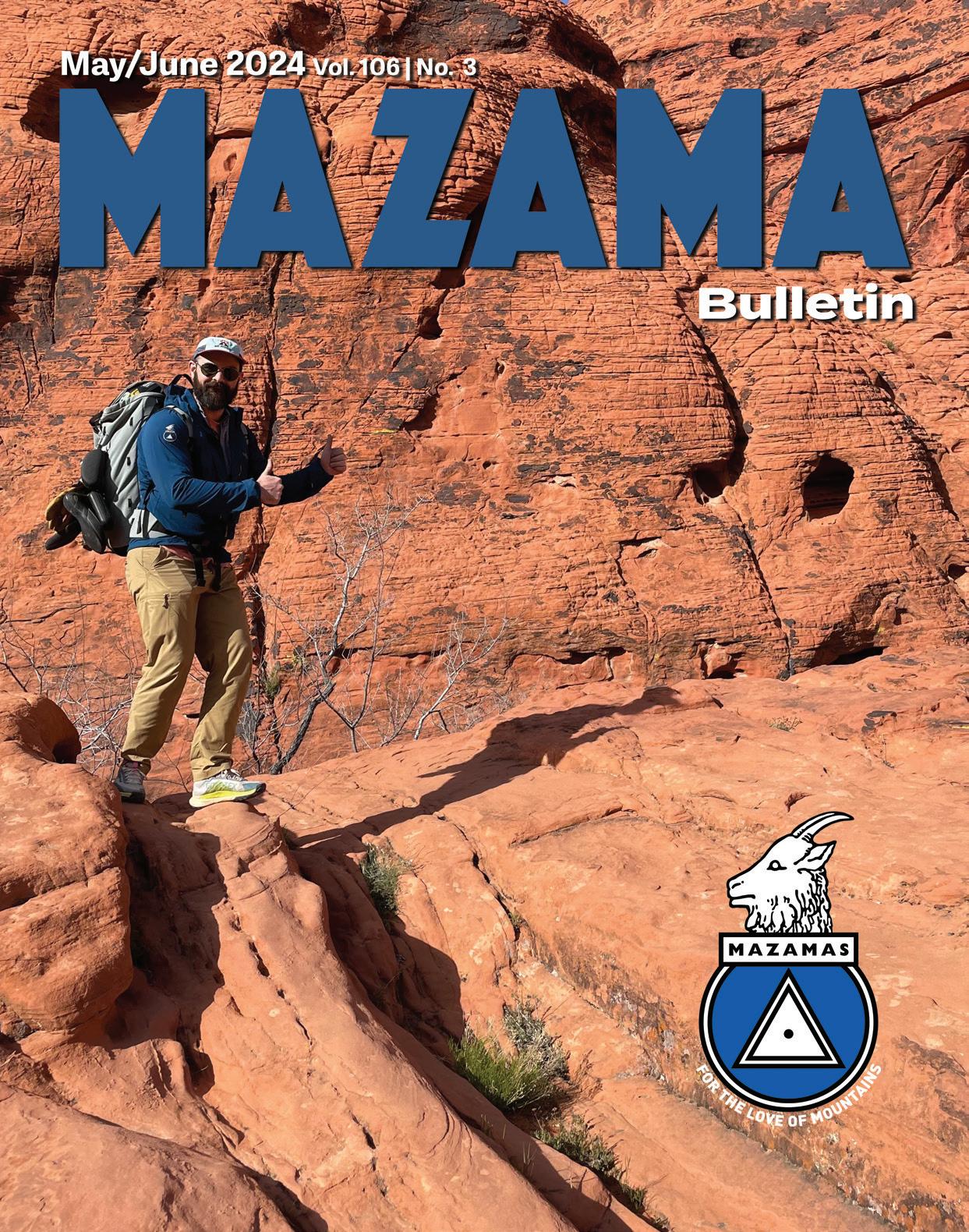
INSIDE: Exploring New Zealand’s Southern Alps Round the Mountain 2024 A Guide to Climbing with the Mazamas History of the Federation of Western Outdoor Clubs




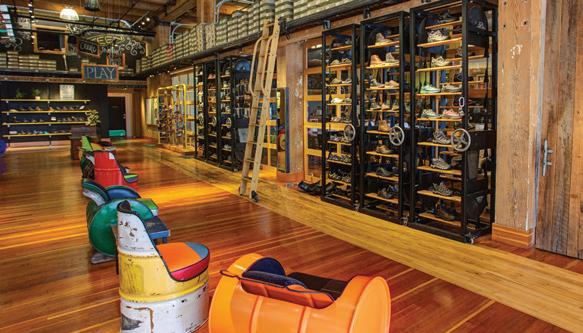
Since 2010, we’ve opened the KEEN Garage to all our Portland fans. It’s a place to get your hands on, and your feet in, the largest selection of KEEN footwear anywhere. It’s also a great place to meet fellow KEEN fans and to be inspired by how they have fun outside. Need insider tips from KEENmates about the styles that best suit your outside life? Come down to the Garage. Wanna test out how each of our styles fit? The Garage door is open. Slap high fives, share trail tales, or just spin the shoe racks. The Garage is there for you.
We mentioned the Garage is filled with the largest selection of KEEN footwear anywhere, right? There’s nowhere else to test out the fit and finish of so many different styles you may have only seen online. Go ahead, pull on those hikers you’ve always wondered about, feel the comfortable joy of the newest generation of Newport sandals, make sure your fave pair of socks will look good in ‘em. Make yourself right at home.
Plus, the Garage features in-person only savings events throughout the year, hosts the occasional party, and is fun for the kiddos (and the adultos, too). Heck, the Garage even has a near-perfect score on TripAdvisor— it’s that kinda fun. And there’s even free parking for KEEN fans right there at the Garage. We’ll see you there.
KEEN GARAGE
505 NW 13th Ave, Portland, OR 97209 971-200-4040
MON - THRS 10AM – 5PM, FRI - SAT 10AM – 6PM, SUN 11AM – 5PM
2 MAZAMAS
www.markcreevey.com
MAZAMA BULLETIN
Volume 106 Number 3
May/June 2024

IN THIS ISSUE CONTENTS
FEATURES
Exploring New Zealand’s Southern Alps: An Outdoor Recreation Paradise, p. 7
A Guide to Climbing with the Mazamas, p. 12
The Bulger List and 100 Summits, p. 13
The Federation of Western Outdoor Clubs and the Mazamas, p. 16
Recollections of My Early Years with the Federation of Western Outdoor Clubs, p. 17
COLUMNS
Executive Director’s Message, p. 4
President’s Message, p. 5
Upcoming Courses, Activities, and Events, p. 6
The Mazamas Welcomes New Members, p. 14
Mazama Classics, p. 22
Successful Climbers, p. 22
What’s Ahead for the Mazama Bulletin?, p. 24
Round the Mountain, p. 25
Looking Back, p. 26
Sunday Skill-builders: Something for Everyone, p. 27
Board of Directors Minutes, p. 28
Saying Goodbye, p. 31
Cover: Brendan Scanlan Red Rocks Canyon National Conservation Area, Sunday, April 7, 2024.
Staff, volunteers, and the board remain committed to elevating the Mazamas in our community.” p. 5
In late 2023 the stars aligned, and we were able to spend almost six months hiking, trail running, mountaineering, and rock climbing in this breathtaking country.” p. 7
Remember that all climb leaders are volunteers. Be kind to them. They’ll be kind to you.” p. 12
The Federation of Western Outdoor Clubs (FWOC) has been a quiet but constant reminder for the Mazamas that our outdoor and conservation advocacy doesn’t just end with the issues that immediately concern us.” p. 16
Leave no trace” is somewhat of a buzzphrase in the outdoor community, but what does it actually mean?” p. 18
MAY/JUNE 2024 3
Above: Kate Woodman crossing the Waimakariri River, New Zealand.
Photo by Kyle Tarry.
Photo by April Henderson.
EXECUTIVE DIRECTOR’S MESSAGE
by Rebekah Phillips, Mazama Executive Director
Welcome to our newest members, and congratulations to the graduating BCEP Class of 2024! Climb season is officially upon us, and we can’t wait to see everyone out there.
Spring, they say, is the time of plans and projects, and we’ve got both in spades at the Mazamas. Though still early in the year, the financial outlook is stable, with program revenue, membership revenue, and contributions all on track through the first quarter. Expenses are also under control. Our new Development Director, Lena Toney, joined us on May 1 and brings a keen understanding of the membershipbased non-profit business model. Lena, the Board of Directors, and I are looking forward to working with members, community partners, and foundations to demonstrate the impact of the inspiring work we do as educators, volunteers, and stewards of our mountains.
On September 25, you’ll have an opportunity to attend our 130th Anniversary Dinner and Benefit event, Steps Together. As the year’s single major fundraising event, Steps Together draws on the spirit of kinship and camaraderie to bring 200 Mazamas and community luminaries together for an engaging and energetic evening that showcases the power of the mountains to inspire belonging, enrich communities, and uncover our shared humanity. It’s sure to be a night to remember, so please mark your calendars and watch for tickets to go on sale.
It’s been six years since the Mazamas conducted a comprehensive membership survey. Quantitative research helps leadership understand opportunities and threats through objective data; our goal is to learn more about our changing membership and its needs, see trends over time, isolate anomalies, and better understand who we are, collectively. Please
take a few minutes to complete the survey when you receive it, and know that in doing so you are helping us better respond to member needs and align our strategies with your priorities.
Earlier this year, I asked committees to consider ways we can increase activity and programming capacity as another way to strengthen our position and expand our reach. Many of you sprung to action, including our Trail Trips Committee, which has organized Round the Mountain for Labor Day weekend, 2024. Round the Mountain is a three-day circumnavigation of Mt. Hood, offering hikers sublime alpine meadows, crisp glacial creek crossings, and stunning views of Wy’East. See more information on page 25, and register by June 30 for this once-in-a-lifetime experience.
Last but not least, the Mazama Lodge is also at the center of our planning. I want to thank the 150 donors who helped us meet a $25,000 goal in March and April as part of our Lodge Roof Matching Challenge. As well, on behalf of the Board of Directors and members of the Mazamas, I wish to extend an especially heartfelt thank you to the very generous anonymous donor who put down the $25,000 match incentive. Combined with contributions and pledges made late in 2023 by the Board of Directors, these funds significantly relieve the burden of what seemed like a daunting expense at the onset. Thank you, Mazamas, for coming together for one another! Much of this work is done with the memory of Yun Long Ong (1972–2021) near to our hearts. A gifted climb leader, story-teller, and a friend to all, Long’s love for climbing, his fellow

Mazamas, and the Mazama Lodge was unwavering.
With a new roof soon to be in place, the Mazama Lodge–at once our mountain home, campus for field learning, gateway to Mt. Hood, and gathering place for community–is well positioned to reopen later this year, and we’re eager to begin leveraging this asset in service of our mission and activities. Though it once functioned as a members-only amenity, the Mazamas simply isn’t in a position to maintain and invest in a second facility that doesn’t yield financial return. Our immediate goal is to identify an operational model that combines member and guest needs in a way that, at a minimum, breaks even. Once we achieve that, we’ll be in good shape to think more strategically and creatively around what more the lodge can do to further our mission and impact on the mountain.
Thank you for all that you have done, and continue to do, to make the Mazamas what it is today: a vibrant community of people whose shared love for the mountains transcends social, economic, and political differences to build an entity much bigger than the sum of our parts. We couldn’t do it without you.
4 MAZAMAS
PRESIDENT’S MESSAGE
by Greg Scott, Mazama President
What are you going to climb this year? I get this question a lot this time of year. It comes from peers, students, people who like climbing with me, and my family. I wish I had time to climb everything with everyone all at once, but priorities in life always make me adjust my expectations. There are no guarantees when you go climb a mountain.
But I can assure you, if you climb with the Mazamas, you are guaranteed to make friends and have a story to tell afterward. If climbing a mountain is a priority for you this year, I hope you will choose to do it with the Mazamas. Who knows, maybe we’ll even climb together! But one thing you don’t have to think about while out on your climb is how the Mazamas are making that experience happen for you. Staff, volunteers, and the board remain committed to elevating the Mazamas in our community.
First, a huge thank you from the board to everyone who contributed to the lodge fundraising campaign. The number of donors who contributed is a sign our community is stronger than ever. I want to especially thank the anonymous donor who matched our campaign at $25,000. I look forward to seeing the lodge develop back into a place where we can all meet and recharge on the mountain and create new stories.
If you’re like me, and keep up on the eNews, you’ve probably noticed an uptick in activity from our leadership. Rebekah is busy helping the board work on a new strategic vision, planning our 130-year
anniversary celebration, and hiring new folks. A big welcome from the board to our new Finance & Administration Manager, Cathy Dow, and Development Director, Lena Toney. Both these positions are critical to achieving our financial and cultural goals. I look forward to what we can do with these new positions under our new bylaws. I also want to thank some of our volunteers, particularly those who are digging into reforming our Risk Management Committee and those stepping up (literally and figuratively) to make our Round the Mountain event the best version yet.
Finally, the Mazamas recently received an invitation from the Murdock Trust Board Leadership and Development Program. Rebekah, board secretary Matt Sundling, and I will be attending this program in May and June. I expect this experience will inform how we continue to professionalize and strengthen our board leadership.
Thank you to everyone for your continued commitment to our community. I hope to see you out in the mountains this summer.


MAY/JUNE 2024 5
UPCOMING COURSES, ACTIVITIES, AND EVENTS
HIKING THE SAWATCH

Registration closes: May 15, 2024
Dates: August 19–26, 2024
Cost: $725 members/nonmembers
Join us for a seven-day outing in the area of Colorado that boasts the highest concentration of summits over 14,000 feet in the entire state and is home to the whitewater of the Arkansas River. We will enjoy daily “B” level hikes at elevations reaching between 11,500 and 12,500 feet among gorgeous mountains and pristine alpine lakes. We will have the opportunity to raft in the whitewater of the Arkansas Headwaters Recreation Area, known for being home to some of the best rapids in the country.
We will be staying in the little historic mining town of Buena Vista, elevation 8,000 feet, in a 5-bedroom, 3½-bath house whose backyard comes down to the soothing waters of Cottonwood Creek.
Participants are responsible for their travel and meals. Full payment is required by the signup deadline of May 15, 2024. Cancellation after July 1, 2024, will result in forfeiture in full unless and until a satisfactory replacement is found.
Only those fully vaccinated against COVID need apply.
More info: bit.ly/SawatchMtnsMazamas
STEEP SNOW & ICE 2024 ROUND THE MOUNTAIN 2024
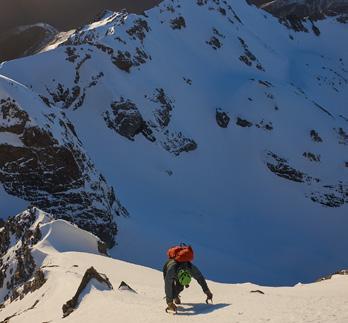
Virtual Info Night: May 22, 6 p.m.
Please join us to learn more about the 2024 Steep Snow & Ice Skill-builder. There will be a short presentation and photos of the fun we have on Eliot Glacier. Members of the SSI team as well as past students will be available to answer questions.
Registration open: June 1, 2024
Dates: August 6–25, 2024
Cost: $300 members/$375 nonmembers
Steep Snow & Ice is pleased to announce dates for our 2024 skill-builder. This short class of several evening sessions, practice on the foam artificial ice wall at the MMC, and a weekend field session provides training on winter alpine protection and movement to help prepare climbers to tackle objectives such as Mt. Hood’s Reid Headwall and Mt. Rainier’s Kautz Glacier route. All classes are from 6–9 p.m. at the MMC.
Course dates:
■ SSI class #1: Tuesday, August 6
■ SSI class #2: Thursday, August 8
■ SSI class #3: Wednesday, August 14 (Group A)
■ SSI class #4: Wednesday, August 21 (Group B)
■ SSI field session: August 17–18 (Group A)
■ SSI field session: August 24–25 (Group B)
Mark your calendars! Round the Mountain (RTM) is back this Labor Day, Aug. 30–Sept. 2, 2024. Join us as we set out from the Mazama Lodge each day for a 13 to 14-mile adventure. We carry only day packs because each night we return to the lodge for great food, hot showers, a cozy bunk, and stories from your day on the trail. Your adventure includes all meals and dorm lodging. Shuttle vans will transport you from our meeting place in Portland to the Mazama Lodge, as well as to/from the trailhead each day. See “Round the Mountain” on page 25 for more info.
SOUTH OLYMPICS TREK

Dates: September 8–14, 2024
Cost: $350 members/$500 nonmembers
Join us as we hike the beautiful and scenic southern Olympics Coast Wilderness completing a loop along the Skyline Ridge, Elwha River, Hayden Pass, Dosewallips River, West Fork Dosewallips River, LaCrosse Pass, Duckabush River, O'Neil Pass, and East Fork Quinault River trails. The 6–8 participants will need to be in good physical condition for this approximately 101-mile adventure and should have experience in at least one 50+ mile trek. We will be hiking at a moderate to fast pace, traveling around 10–21 miles per day over easy to difficult terrain, including stream fords. Elevation gains will range from 3,600–5,800 feet per day. Expect varying weather, wildlife, and miles and miles of scenery. We will use a short car shuttle to complete this loop hike.The outing dates are tentative until a permit is obtained.
More info: bit.ly/SOlympicsMazamas
6 MAZAMAS
EXPLORING NEW ZEALAND’S SOUTHERN ALPS: AN OUTDOOR RECREATION PARADISE
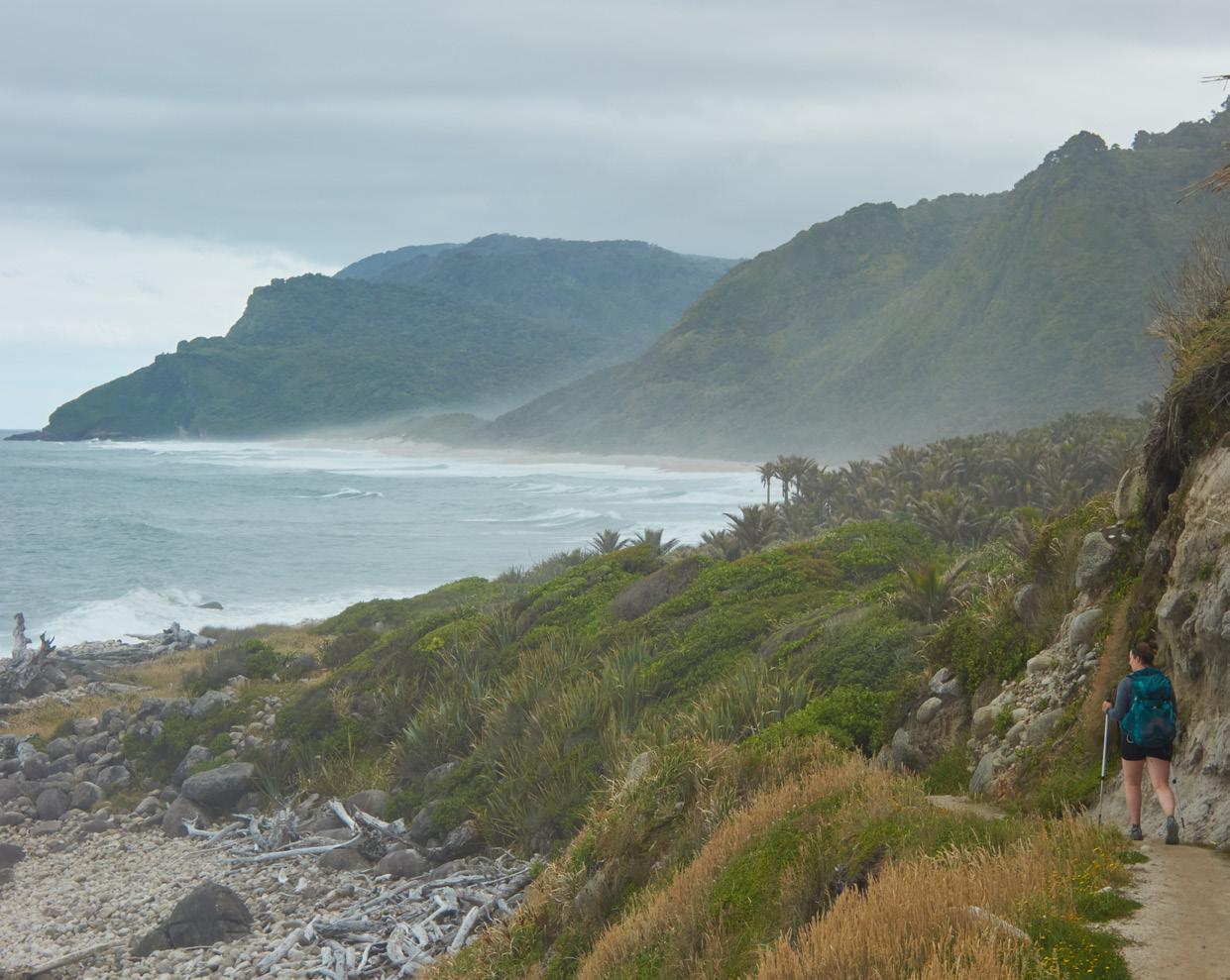 by Kyle Tarry
by Kyle Tarry
Located at 45 degrees latitude in the South Pacific, New Zealand has a similar climate to the Pacific Northwest, but with opposite seasons—making it an appealing escape from northern hemisphere winters. My wife and I had made several working trips to the country since 2011, and we were on the lookout for an opportunity to take a longer trip more focused on outdoor recreation. In late 2023 the stars aligned, and we were able to spend almost six months hiking, trail running, mountaineering, and rock climbing in this breathtaking country.
Originally settled by the Maori (seafarers from Polynesia) around 1300 AD, and then colonized by the British in the 1800s, New Zealand’s history of human occupation underscores its remoteness from other major landmasses. The country is comprised of two large islands, the
North Island and South Island, and several hundred smaller outlying islands.
The South Island is particularly notable for its vast alpine environments. The collision of two tectonic plates forms a fault line about 400 miles (600 kilometers) long, which pushes land toward the sky in an impressive chain of mountains
running nearly the entire length of the island. This range is named the Southern Alps, in an obvious nod to the European history of the area. Elevations are not especially high, rarely exceeding 10,000 feet (3,000 meters), but the immense vertical relief and significant glaciation
continued on next page
MAY/JUNE 2024 7
Above: Kate Woodman on the Heaphy Track, New Zealand.
Photo by Kyle Tarry.
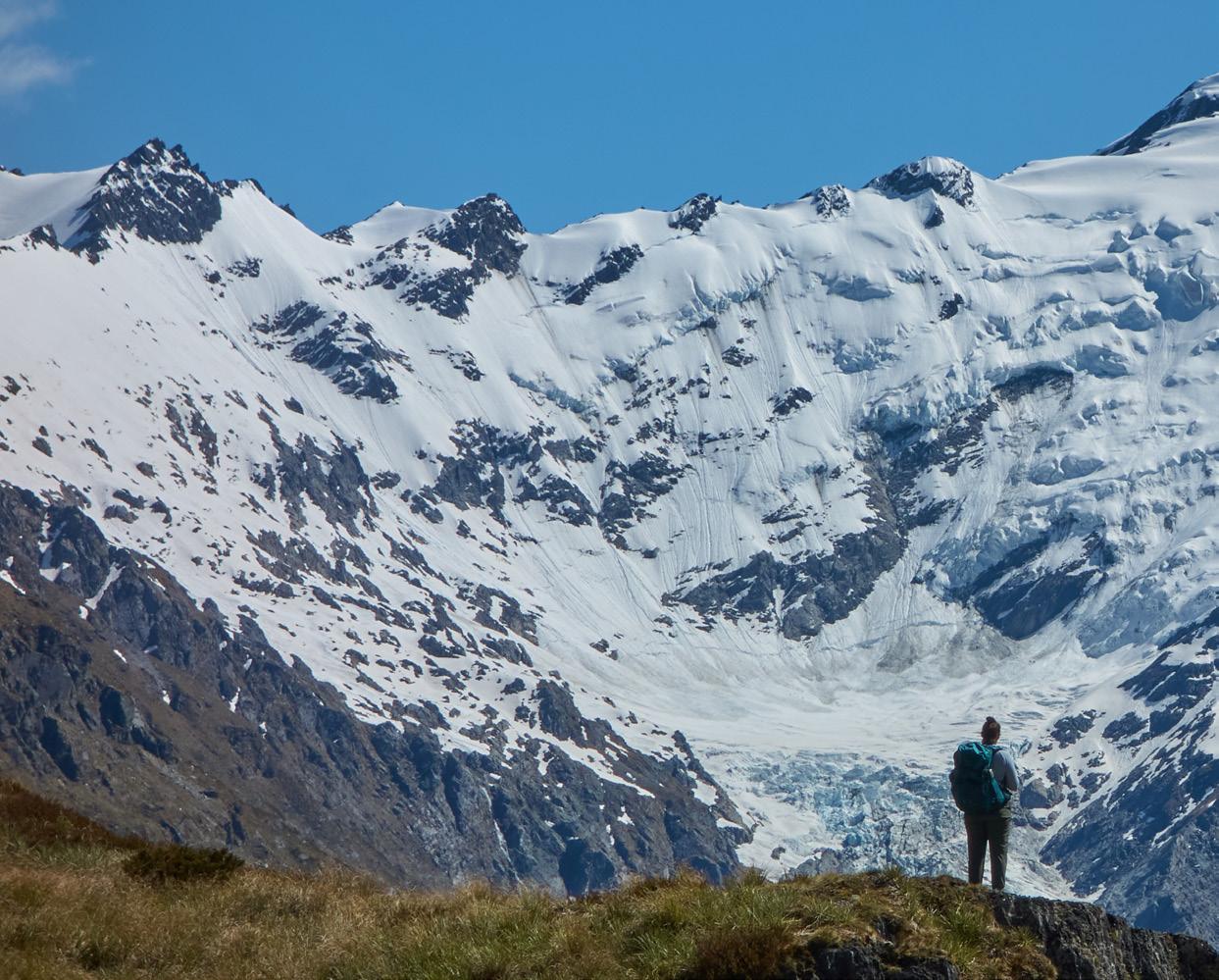
NZ, continued from previous page.
result in an extraordinary landscape. The tallest mountain in the Southern Alps, Aoraki/Mt. Cook (peaks in New Zealand are generally described using both Maori and European names), is 12,218 feet (3724 meters) tall and sits only 30 kilometers from the Pacific Ocean (for comparison, Mt. Baker lies 50 kilometers from Puget Sound). Vertical relief on such a large scale results in steep valleys, hanging glaciers, and sheer mountain faces. With a low tree line and significant deforestation, New Zealand landscapes tend to be much more open than the PNW, with immense views presenting themselves at nearly every turn of the road or trail.
The South Island is broken into regions by terrain, each with its own character.
In the northwest corner, Golden Bay and Kahuraungi are warm, sunny, and nearly tropical. The West Coast, the strip between the ocean and the Southern Alps, is extremely rainy due to weather systems moving in from the west. East of the mountains lie Marlborough, Canterbury, and Otago, which are generally drier and sunnier due to a pronounced rain shadow (similar to eastern Washington and Oregon). To the southwest lies Fiordland and Southland, a remote and stormy region home to glacially carved fjords and sounds.
TRAMPING
Hiking, known as “tramping,” is a popular pastime for Kiwis (native New Zealanders). Visiting trampers will find
many similarities to what they are used to in the Northwest, with a few exceptions. Most notably, New Zealand has an extensive backcountry hut system, which enables trampers to forego tents and sleep in relative comfort. Hut amenities vary, from small run-down sheds to large modern lodges, but a typical hut will have a water supply, tables for cooking and eating, and sleeping mattresses on basic bunk beds. Huts generally cost $10–20 per night, and while some must be booked online in advance, many are first-come, first-served. Tent camping is still common and can be convenient, but it is possible to structure itineraries such that you never need to sleep on the ground.
8 MAZAMAS
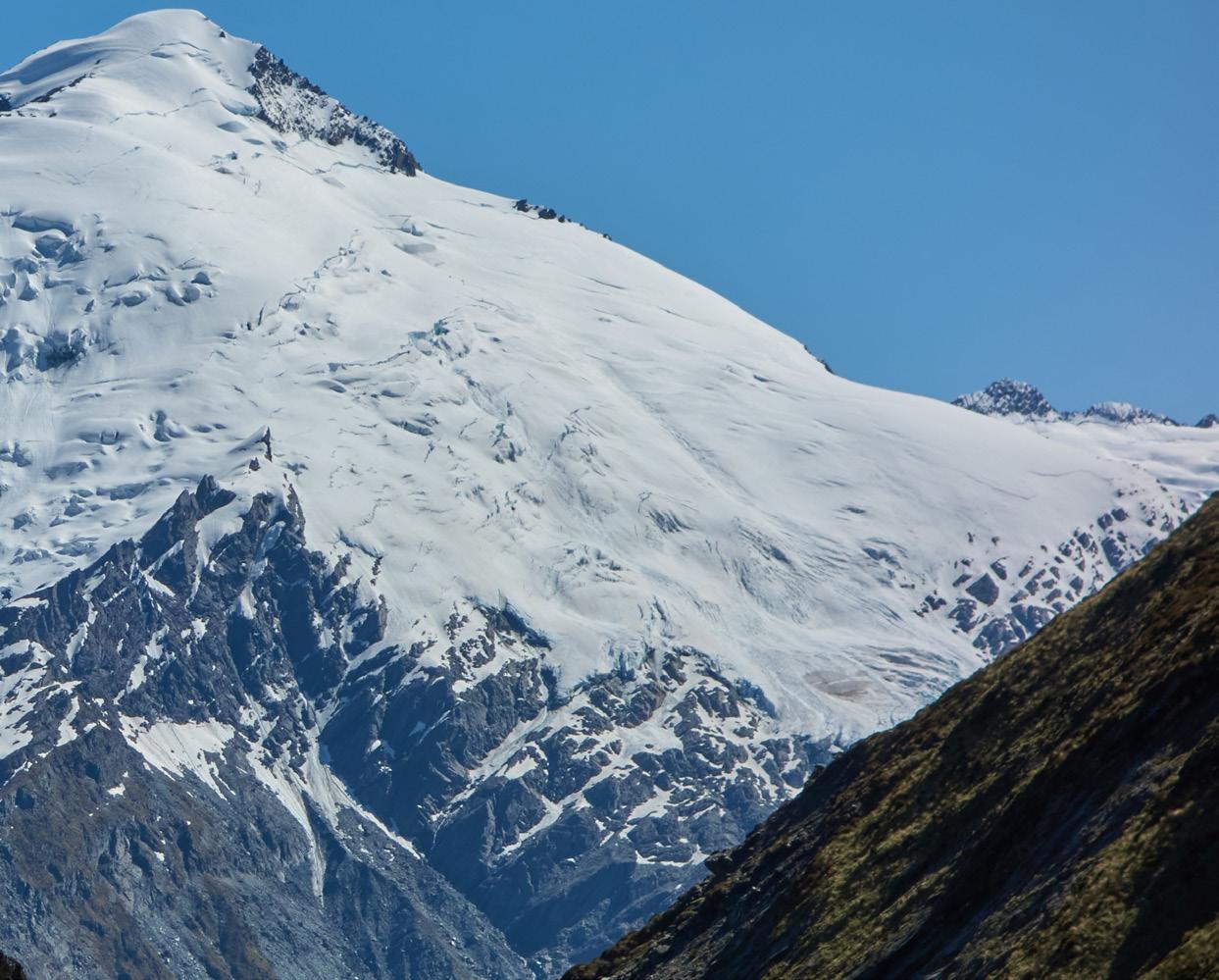
Trails (“tracks” in local lingo) vary in construction and maintenance, but expect steep climbs and moderately rough singletrack. Unbridged creek and river crossings are common. Nearly everything in New Zealand feels like a classic Gorge lung-buster like Dog Mountain or Mount Defiance. Unlike the Northwest, there are no large predators (bears, cougars, wolves), nor many poisonous creatures. However, there are some cheeky birds (kea, weka) and rodents (possum, stoat) that will get into your scroggin (trail mix), so be careful with snacks. There are some mosquitos, and small biting black flies called “sandflies” that are common in wet areas (especially the west coast) and can be a real nuisance.
A special classification of track, the Great Walks, are designated trails that showcase many of the country’s premier landscapes. Great Walks are extremely popular and require advance hut bookings, some of which will be reserved six or even 12 months in advance, and cost quite a bit more than a basic hut. We completed the Kepler Track (60 kilometers) and the Routeburn Track (30 kilometers) without hut reservations by running them in a day. We also completed the Abel Tasman Coast Track on a traditional five-day, four-night itinerary, visiting in late October (well before peak tourist season). There are plenty of impressive landscapes off the Great Walk system if you prefer to be away from the beaten path. The Department
of Conservation (DOC), the New Zealand equivalent of the Forest Service, has an impressive database of nearly every notable hut and hike and is a very useful resource.
MOUNTAINEERING
New Zealand’s highly glaciated landscape, steep mountains, moderate climate, and low altitude make it an ideal alpine playground for mountaineers. The primary hubs for alpine climbing are the Aoraki/Mt. Cook region (based out of the small hamlet of Mt. Cook Village) and Mt. Aspiring National Park (near Wanaka). Many other regions of interest also exist, such as Arthur’s Pass National Park and the Darran Mountains. Like tramping, continued on next page
MAY/JUNE 2024 9
Above: Kate Woodman, Mt. Edward from Rees Saddle, Ress-Dart Track.
Photo by Kyle Tarry.

NZ, continued from previous page
mountaineering is frequently conducted using huts as base camps, and an impressive network of high-altitude alpine huts is maintained by DOC and the New Zealand Alpine Club (NZAC).
Similar to the Cascades, the Southern Alps mountaineering season runs from spring into summer. Alpine ice objectives are at their best in spring (October), and the large glaciers are most easily traversed in early summer (November, December). Many objectives are climbable year-round, and there is a rich history of difficult winter ascents.
Access to New Zealand’s mountains can often be a significant undertaking, sometimes as difficult as the climbing itself; veterans of the Picket Range or Cascades bushwhacks will feel at home here. Glacial recession is very evident in this landscape, and the remnants of recent glaciation can result in both arduous travel and objective hazards. Scrambling up a loose lateral moraine beneath boulders seemingly suspended in air is a disturbingly normal occurrence, and the alpine rock in the region is often low-quality choss. The glaciers themselves also show the effects of a highly dynamic landscape, and
many popular routes are threatened by seracs. While the elevations are similar to the Cascades, the steepness and degree of glaciation are more similar to the Alaska Range or the Cordillera Blanca, so parties interested in the high summits should have extensive glacier and steep snow experience.

Above top: Climbers on the SW Rige of Tititea/Mt. Aspiring.
Due to the dynamic landscape and recent changes in the low-elevation glaciers, it is increasingly common to book a helicopter flight directly to the alpine hut closest to your objective. This significantly reduces the time and effort spent approaching and avoids a lot of nasty moraine travel, but it comes at a cost, as bookings are done by the full helicopter load (approximately $1,500 NZD/$1,000 USD each way as of 2024). If you can find a couple parties headed the same way, splitting this cost helps ease the burden.
A climber desiring to summit Aoraki/ Mt. Cook will usually follow the standard Linda Glacier route, with a base camp
Above inset: Jon Coppi, Aoraki/Mt. Cook at dawn from Hooker Valley, apporaching Empress Hut.
Photos by Kyle Tarry.
at the impressive Plateau Hut (perched on a small rock outcropping in a large glacier basin at 2,200 meters). This route is moderately technical, with extensive glacier travel, steep snow, and some easy mixed climbing, and is steep enough to necessitate some rappelling on the descent. A step up from the Linda Glacier is the ultra-classic Grand Traverse, which traverses the knife-edge summit ridge of Aoraki/Mt. Cook for a linear mile, requiring front pointing across hundreds of meters
10 MAZAMAS
of calf-burning alpine ice. I attempted this route in mid-November and found it committing and remote. We took a full day approaching to Empress Hut, which is perched on a rock outcrop below Aoraki and Mt. Hicks at 2,500 meters, and then began the traverse by climbing the SW Couloir of Aoraki/Mt. Cook. We successfully summited Aoraki Low Peak (the first of three high points along the ridge), but were turned back before completing the traverse.
The Aoraki/Mt. Cook area holds a high concentration of other notable peaks, with 15 out of the 16 3,000-meter summits in this area. Classic objectives include Mt. Sefton, Mt. Tasman, and Mt. Hicks, all 3,000-meter peaks requiring technical climbing to the summit. There are innumerable smaller peaks, between 2,000 meters and 3,000 meters, which vary from easy walk-ups to scrambles to technical ice and rock climbs. I enjoyed a fantastic day of scrambling and snow climbing on a traverse of the Sealy Range above Mueller Hut, summiting Mt. Olliver, Kitchener, and Annette, a fantastic outing that provided
NEW ZEALAND TRAVEL TIPS
For such a remote location, travel logistics are surprisingly simple. The essentials:
■ Flights depart daily from San Francisco and Los Angeles and arrive in Auckland (the capital city, located on the North Island) 12 hours later; from there, it’s only a short hop to various South Island destinations such as Christchurch, Queenstown, and Nelson. At the time of this article, a round-trip flight can generally be had for $1,500–$2,000 USD.
■ For US visitors, a formal tourist visa is not required for stays of 90 days or less; just submit a travel application (“NZeTA”) digitally before your trip.
■ For fewer crowds, consider visiting before or after the peak season, January through February, when local schools are off for their summer break.
■ Make sure all pieces of outdoor equipment (boots, tent stakes, trekking poles, etc.) are completely cleaned of dirt and debris. Due to its
breathtaking views of the larger peaks in the range.
Mt. Aspiring National Park contains the remaining 3,000-meter peak, the eponymous Tititea/Mt. Aspiring. Tititea has several popular routes, from rock scrambles to technical ice climbs. Further north, at Arthur’s Pass, we climbed the classic Rome Ridge on 2,200-meter Mt. Rolleston, an aesthetic ridgeline with long sections of steep snow climbing and short bits of rock scrambling. Elsewhere in Arthur’s Pass, there are opportunities for scrambling and snow climbing on peaks such as Philistine, Carrington, and Murchison. Further south, the Darrans are a pocket of notably high-quality alpine granite and steep rock faces more reminiscent of classic granite ridges in the Cascades. Thick foliage, steep valleys, and challenging weather have given this area a reputation as a challenging but rewarding climbing destination.
When your sore feet need a rest, there are some great rest day options. Marlborough and Otago have burgeoning wine scenes (Sauvignon Blanc and Pinot,
geographic isolation, New Zealand’s unique ecosystem is extremely susceptible to invasive species, and officials will not hesitate to throw away anything that might carry an unwanted seed or fungus.
■ Public transit is limited and won’t get you to remote trailheads. Rent a car for short visits; for longer stays, it might be cheaper to buy a car and sell it before you depart. Aside from driving on the left side of the road (like the British) and adapting to the metric system, getting around isn’t much different than in the US.
■ The climate is similar to the Pacific Northwest in the summer, with milder temperatures (rarely exceeding 80 degrees F); however, solar radiation is approximately 40 percent greater, so sun hoodies, sunglasses, and sunscreen are not optional.
■ Financial transactions are almost exclusively digital. Make sure your credit cards have a chip and/or are tap-to-pay capable. As of this writing, the exchange rate is a favorable 0.6 USD per NZD, so things look more expensive than they are.
respectively). Kaikoura is world-renowned for marine life and offers whale, seal, and dolphin watching. For the adrenalin junkies, stop into Queenstown for a bungee jump or a jet boat ride. Consider a boat ride in Milford Sound, a unique environment of huge vertical relief directly out of the ocean that needs to be seen to be experienced. Delicious meat pies can be found in nearly every small-town cafe, with especially great examples in Fairlie and Sheffield, and fish and chips are ubiquitous and delicious.
Whatever your recreational interest, a visit to New Zealand is virtually guaranteed to provide awe-inspiring landscapes and lasting memories.
■ Local goods can be quite affordable, but you’ll pay a premium for imported goods manufactured or grown elsewhere. Where possible, bring expensive equipment like climbing gear with you from home.
■ On the whole, New Zealand is culturally quite similar to the US; English is the main language, fries are fries, and chips are chips. Shoes, however, are optional in your local cafe and grocery store.
MAY/JUNE 2024 11
A GUIDE TO CLIMBING WITH THE MAZAMAS
by the Mazama Climbing Committee
This guide covers etiquette, advice, and expectations for those seeking to climb with the Mazamas, including applying to climbs, being accepted, preparing for the climb, and participating on the climb. Remember that all climb leaders are volunteers. Be kind to them. They’ll be kind to you.
CHOOSING CLIMBS
■ Apply for climbs that are appropriate for your skill level, comfort level, and experience. Consider the skills required for the climb. For instance, if you don’t have any training in crevasse rescue, you should obtain that before applying for a climb of Mt. Rainier. If you are not comfortable with 5th-class rock and exposure, perhaps do some private climbing on that terrain before applying for The Ogre.
■ There are numerous classes offered by the Mazamas that can help you obtain the skills necessary for you to meet your climbing goals.
■ You will be climbing as a member of a team and contributing your skills to the success of the climb. While different skill levels can usually be accommodated, there may be a point where participation isn’t possible.
■ If you are unsure of the skills required for a climb, contact the climb leader for clarification.
GETTING ACCEPTED
Mazama climb leaders consult a variety of factors when selecting participants. Though we cannot guarantee you’ll be accepted on every climb, here are some tips for ensuring that climb leaders have the information about you they need to make the best decision possible.
■ Have a resume and share it. Google Docs is a good way to share a climbing resume. Leaders will look at your Mazama profile and see your training
and climbing through the Mazamas there.
■ You can add information about additional climbing and training to your profile or you can link to a resume there. The resume format used by the Intermediate Climbing School (ICS) is a good template. Feel free to use this, especially if you intend to apply to ICS in the future.
■ Without this information, leaders will likely not select you.
■ Team selection can be the most difficult part of organizing a climb. Leaders look at skills and experience but also consider your volunteering history as well as whether or not you’ve been accepted on other climbs and strive to balance their teams by gender and background.
■ Climbs may consist of diverse groups with skill levels from beginner to advanced, depending on the circumstances and requirements for the climb. Sometimes, when all things are equal, being accepted comes down to a flip of the coin. Most often there are far more applications to a climb than there are available spots.
■ Include a photo on your profile. This is optional but completes your profile and can help with finding team members at the trailhead. It's also an opportunity to show yourself enjoying the mountains!
■ If you end up on the waitlist, check in with the leader.
DO REVIEW
■ Review our Cancellation Policy (www. mazamas.org/policies), and remember, climb leaders can see your climb history, including your cancellations.
DO NOT!
■ Apply for multiple instances of the same climb. This can cause excessive “churn” if/when you are selected for the same climb and creates extra work for climb leaders. It also fills up the available application spots and deprives others of an opportunity to apply for the same climb. Be able to complete the climbs you apply for without conflicting with
other climbs. Consider your travel and recovery time!
■ Apply for climbs on the same day. Again, this creates unnecessary churn when you’re accepted to multiple, conflicting climbs.
■ Wait until the last moment to cancel. We understand that life happens and you sometimes need to cancel. Please cancel through the website as soon as you know you won’t be able to participate, even if you’re on the waitlist, as this allows the climb leader time to fill your spot. Canceling within a few days of the climb presents the leader with the challenge of filling your spot while trying to finalize the last-minute preparations like the checking weather, printing permits, and communicating with the team. At this point, the prospectus and carpools have likely been set and changes are more difficult. Filling your spot may not be possible.
PARTICIPATING ON THE CLIMB
■ Respond to emails and other communications in a timely manner. The leader will likely send an email with information about the climb a week or two in advance. Confirm with the leader that you received the information.
■ Be prepared with your gear. Be on time. If there are specific skills required for the climb, refresh yourself on those skills by reading appropriate sections of Freedom of the Hills, practicing knots, and watching YouTube videos. Invest in your preparedness.
■ On the climb, help carry the rope and other group gear. Contribute to the group gear with a stove or water filter. Help with flaking and/or coiling the rope. Communicate concerns. Ask questions. Look out for your and other’s needs. Be a team player.
■ Decision-making may involve group consensus or may be at the discretion of the leader. Participate in the decisionmaking but understand that some decisions may not be up for debate.
■ Understand that the team's pace may make or break the ability to summit. The pace of the climb should be noted
12 MAZAMAS
on the climb activity on the website. Your pace may be slower than is appropriate for the climb and you may be turned back at the leader's discretion. Your pace may be faster as well, and you may have to slow down to accommodate the team. These are the realities of climbing as a team. Communicate any concerns you have about pace. There may be adjustments that can be made. It’s best when we can all reach the summit and your leader and team members want to help if you need a little extra support. We’ve all had our “off” days and have leaned on the support of others.
■ If you have any health issues before or during the climb, express them to the team or to the leader in confidence as appropriate. Health issues can create serious problems if not addressed properly.
■ Be considerate of your team members. We all have different backgrounds and experiences. Consider that expressing strong opinions about social or political issues may create an uncomfortable environment. Be open to other views. Remember, the goal is climbing—conversations we have during the process of climbing should enhance the experience, not degrade it.
CONTACT INFO
■ Have an emergency contact listed on your Mazama profile on the website.
■ Please do not list an emergency contact who will be climbing with you or out climbing while you’re climbing, or will be otherwise unavailable.
THE BULGER LIST & 100 SUMMITS
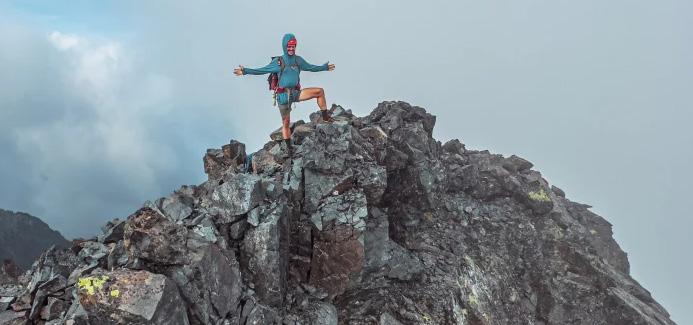 by Mathew Brock, Mazama Library and Historical Collections Manager
by Mathew Brock, Mazama Library and Historical Collections Manager
In 1976, a group of climbers, who called themselves the “Bulgers” or “Bludgers” (the name comes from a mispronunciation of the word “bludger” [a lazy person] in an Australian poem), compiled a list of the 100 highest peaks in Washington State that has come to be known as the Bulger List.
To be included in the list, peaks generally need to have at least 400 feet of clean prominence from the surrounding area, while the list makes exception for volcanoes—they need 800 feet of prominence to be considered for the list. The highest peak on the list is Mt. Rainier at 14,411 feet (4,392 meters). Other notable summits include Mt. Adams, Glacier Peak, Mt. Stuart, and Mt. Shuksan. Only a few peaks on the list, such as Mount St. Helens and Windy Peak, have established trails to the summit. Most require off-trail travel, bushwhacking, glacier climbing, and technical rock climbing skills. While never officially sanctioned, the Bulger List has become a well-known challenge for climbers in the Pacific Northwest.
The Bulger List is considered one of the most challenging peak-bagging lists in the United States due to the difficulty of getting to many of the peaks. Thus far, roughly 90 people have completed the list. The first to finish was Russ Kroeker in
1980. In 2021, Jason Hardrath set the fastest known time for completing the complete list in just 50 days, 23 hours. The previous record was closer to 400 days. However, Jason was followed shortly after by 21-yearold Nathan Longhurst, who became the youngest person to finish the list in a single season (94 days). Nathan’s record would stand for nearly two seasons. Then came Andrew Okerlund.
In June of 2023, Andrew set out to set a Bulger List climbing record. At just 20 years old, Andrew now holds the record for the youngest person to climb the Bulger List, and for having done so in one season of 85 days. Andrew’s journey is the subject of a new documentary titled 100 Summits. The film showcases the beauty, ruggedness, and at times treacherous nature of Washington’s 100 tallest peaks. The film will make its Portland premiere on June 9 at the Mission Theater and will debut on YouTube on June 14, 2024.
Find the guide online at www.mazamas.org/climberetiquette
MAY/JUNE 2024 13
THE MAZAMAS WELCOMES
NEW MEMBERS
Between December 1, 2023, and March 31, 2024, the Mazamas welcomed 288 new members. Please join us in welcoming them to our communit!
Korey Abbott
Natalia Alexandra
Mikhail Alkaev
Daniel Allison
Tyler Armstrong
Chev Arnold
David Artis
Christie Artis
Aja Beckett
Murali Siddappa
Badiger
Chris Bafford
Kelsey Baker
Colin Baker
Jonathon Baker
Matt Baldwin
Matthew Barbisan
Noah Bauer
Keith Bean
Aubrey Beard
Michael Bedrosian
Benjamin Bellman
Maya Evangeline
Berman
JJ Bjordahl
Gregory Blachly
Ron Blair
Linda Blake
Kathleen Bonn
Aimee Bonneval
Alex Brauman
Lauren Bray
Benjamin Briscoe
Nicole Bruno
Pratyush Buragohain
Charles Caldwell
Evan Carlson
Sam Carlson
Matt Carney
Christopher Chan
Matthew Choi
Christie Choma
Chad Clark
Philip Clark
Charles Clough
Justin Wade Cochran
Victor Colominasruiz
Edward Colson
Jane Connell
John Connell
Margo Conner
Katelyn Cooper
Magen Cornett
Clay Creger
Glenn Crim
Gabriella de los Santos
Alex Dennig
Nisha Desai
Christina Djabiras
Evan Dodson
Hari Krishna Sai
Donepudi
Mali Dong
Ryder Dopp
Edward Dudlik
Joe Dudman
Eileen Durspek
Allen Dysart
Cameron Elson
Michelle Emery
Matthew Farr
Katie Farrell
Mike Farrell
Ivana Ferguson
Ainsley Filkins
Nick Fiorante
Jane Fitzgerald
Kelly Flanigan
Jeffrey Foster
Victoria Fox
Aimee Frazier
Christian Frees
Melissa Fricke
Hans Friedrich
John Gadon
Curt Gardner
Joann Geddes
Sarah Gibson
Daniel Giggy
Kathy Gilbert
Lise Glancy
Leana Goetze
Mara Gomez
Mafe Gonzalez
Alissa Goslin
Rick Goss
Matthew Graham
Taylor Greely
Jordan Gregoire
María Gudín
Nikolas Gudzikowski
Gretchen Guyot
Melissa Haeffner
Beth Haley
David Wayne Halligan
Cassie Hamann
Byung Gi Han
Erik Hanson
Jonathan Hart
Brandon Hawkins
Lisa Hay
Liam Hill
Luke Horvath
Laura Hubber
Jack Hubner
Emily Humphreys
David Hurley
Megan Hutchinson
Leslie Iverson
Geetha Janardhana
Harishankar
Jayakumar
Nithyananda (Siva)
Jeganathan
Denzil Jennings
Fabian Jimenez
Kelly Johnson
Meg Julian
Carrie Jurkiewicz
Sandeep Koratagere
Mark Kennedy
Aaron Klarenbach
Mariah Kondo
Kaitlyn Kreider
Michelle Lamoreaux
Shannon Lenox
Shalem Lev
Frank Liao
Lauren Link
Eric Liu
Ben Lomme
Katherine Long
Greg Luckeroth
Sarah Lumelsky
Dan Lundgren
Carolina Luviano
Matt Lyons
David Mackovjak
Sohil Makwana
Abdullah Al Mamun
Natalie Mandarano
Kadin Mangalik
Laurie Mapes
Sunita Marathe
Marc Mariano
Stephen Marshall
Daniel Martinez
Christopher Mason
Lise Massey
Josh Matthew
Tiffany Maxwell
David McArthur
J P McCarthy
Dave McCollum
Henry McElroyFuchs
Catherine McLaughlin
Lee McPherson
Rachelle MeenachLigrano
Jacob Mikulsky
Joan Miller
Daniel Miller
Al Miller
Fumi Mori
Gregory Murray
Samuel Neiger
Rachael Nelson
James Neumeister
Chris Nichols
Shannon Nichols
Aimee Nighswonger
Juliana O’Brien
Jun Okano
Kai Olson
Simon O’Gorman
Mary O’Neill
Matt Palmer
Emily Parent
Stacy Park
Wyatt Parno
Sharath Patlolla
Jonathan Patrick
Josee Pearlson
Karinn Pearson
Katherine Peters
Karl Peterson
John Peterson
Daniel Pettigrew
Duyen-Anh Pham
Brie Phillips
John Pies
Tyson Pitts
Mauricio Posada
David Potter
Rachel Punzalan
Michael Putz
Anna Raithel
Lyla Rayyan
Jackson Reed
Deanna Reiber
Jake Reich
Aaron Reyna
Mckenzie ReynoldsStein
Tamer Riad
James Ringelman
Mark Ristaino
Jason Rizk
Marianna Roberts
Yvonne Roberts
Alison Roberts
Clara Robertson
Reigh Robitaille
Katrina Rodakowski
Katie Rompala
Eric Stoddard
Aman Sachdev
Tony Salvitti
Nancy Sander
Maddie Sands
Lana Mirian Santos
da Silva
Matthias Schabel
Matthew Schindlbeck
Benjamin Schmidt
Theia Schonder
Ashley Schroeder
Melani Schweder
Astha Sethi
Molly Setzer
Erin Severe
James Shaver
Jeff Shaw
William Sherwood
Bijaya Shrestha
Melissa Smith
Matt Smith
Christiana Smith
Hunter Spencer
Zach Spidell
Tony Sprauer
John Sprauer
David Spurr
Melissa Stawarz
Patrick Sterns
Dane Stevenson
Edward Stratton
Melissae Stuart
Alec Studier
Carol Stull
Erik Sudheimer
Eric Sullivan
Jamie Sullivan
Kassie Swenson
Chance Tagg
Nora Tanner
Yu Te
Mike Terese
Finley Tevlin
Simon Thornton
Philippe Thuillier
Loralee Trocio
Aaron Troy
Patti True
Amber Valenkamph
Patrick Vance
Jesus Alberto Varela
Lopez
Lauren Vick
Joshua Visick
Ansel Wallace
Kristina Wells
Bill Wessels
Jonathan Wilson
Wes Winton
Harry Witt
Nina Wohlfahrt
Christine Wolf
Aletheia Yamamoto
Jooim Yang
Ashley Yang
Richard Young
Kara Young
Sofiya Zaleeva
Sanja Zelen
14 MAZAMAS
MAZAMA VALUES
Safety
We believe safety is our primary responsibility in all education and outdoor activities. Training, risk management, and incident reporting are critical supporting elements.
Education
We believe training, experience, and skills development are fundamental to preparedness, enjoyment, and safety in the mountains. Studying, seeking, and sharing knowledge leads to an increased understanding of mountain environments.
Volunteerism
We believe volunteers are the driving force in everything we do. Teamwork, collaboration, and generosity of spirit are the essence of who we are.
Community
We believe camaraderie, friendship, and fun are integral to everything we do. We welcome the participation of all people and collaborate with those who share our goals.
Competence
We believe all leaders, committee members, staff, volunteers, and participants should possess the knowledge, skills, abilities, and judgment required of their roles.
Credibility
We believe we are trusted by the community in mountaineering matters. We are relied upon for information based on best practices and experience.
Stewardship
We believe in conserving the mountain environment. We protect our history and archives, and sustain a healthy organization.
Respect
We believe in the inherent value of our fellow Mazamas, of our volunteers, and of members of the community. An open, trusting, and inclusive environment is essential to promoting our mission and values.

Whether you are new to the Northwest, a seasoned backcountry traveler, a longtime Portland resident who’s ready to start exploring, or somewhere in between, we can connect you to the hiking, climbing, and skiing adventures you seek.
■ Climb a mountain
■ Go rock climbing
■ Hike or backpack
■ Backcountry ski or snowshoe
■ Discover canyoneering
■ Meet interesting people
■ Learn new outdoor skills
■ Check out our library
■ Stay at our mountain lodge
■ See a presentation
■ Discover new places
■ Trek in a foreign country
■ Join an outing or expedition
■ Fix a trail
■ ... and so much more!

CONTACT US
Mazama Mountaineering Center
527 SE 43rd Ave., Portland, OR, 97215
Phone: 503-227-2345
Email: help@mazamas.org
Hours: Tuesday–Thursday, 10:30 a.m.–4 p.m.
Mazama Lodge
30500 West Leg Rd., Government Camp, OR 97028
Phone: 503-272-9214
Email: mazamalodge@mazamas.org
Hours: Closed
PUBLICATIONS TEAM
Editor: Mathew Brock, Bulletin Editor (mazama.bulletin@mazamas.org)
Members: Peter Boag, Darrin Gunkel, Ali Gray, Ryan Reed, Jen Travers, and Claire Tenscher (publications@mazamas.org)
MAZAMA STAFF
MATHEW BROCK
Library & Historical Collections Manager mathew@mazamas.org
RICK CRAYCRAFT
Facilities Manager facilities@mazamas.org
CATHY DOW
Finance & Administration Manager cathydow@mazamas.org
REBEKAH PHILLIPS
Executive Director rebekahphillips@mazamas.org
BRENDAN SCANLAN
Operations & IT Manager brendanscanlan@mazamas.org
LENA TONEY
Development Director lenatoney@mazamas.org
For additional contact information, including committees and board email addresses, go to mazamas.org/ contactinformation.
MAZAMA (USPS 334-780):
Advertising: mazama.bulletin@mazamas.org. Subscription: $15 per year. Bulletin material must be emailed to mazama.bulletin@mazamas.org.
The Mazama Bulletin is currently published bi-monthly by the Mazamas—527 SE 43rd Ave., Portland, OR 97215. Periodicals postage paid at Portland, OR. POSTMASTER: Send address changes to MAZAMAS, 527 SE 43rd Ave., Portland, OR 97215. The Mazamas is a 501(c)(3) Oregon nonprofit corporation organized on the summit of Mt. Hood in 1894. The Mazamas is an equal opportunity provider.
MAY/JUNE 2024 15
Join Now!
mazamas.org/join
THE FEDERATION OF WESTERN OUTDOOR CLUBS & THE MAZAMAS
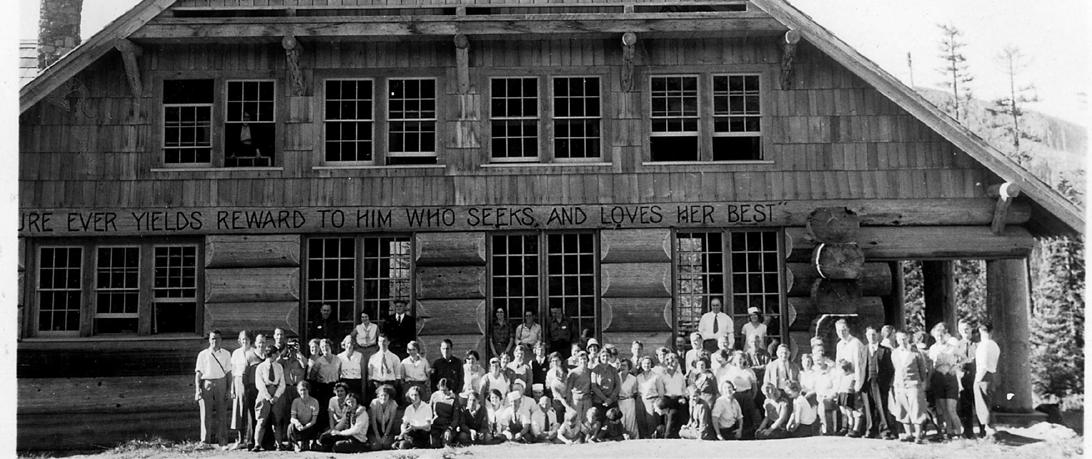 by John Rettig, Mazama Conservation Committee Co-Chair,
by John Rettig, Mazama Conservation Committee Co-Chair,
and FWOC President
The Federation of Western Outdoor Clubs (FWOC) has been a quiet but constant reminder for the Mazamas that our outdoor and conservation advocacy doesn’t just end with the issues that immediately concern us locally in Oregon and Washington—the Mazamas also collaborates with other like-minded outdoor activity and conservation organizations on a much broader scale. Our longest-running organizational involvement in doing this important work has been through the FWOC.
The Mazamas was a founding member of the FWOC and has played a key role since its beginning in 1932 (the FWOC’s founding gathering was hosted by the Mazamas at the original Mazama Lodge on Mt. Hood). At that time, as the United States was becoming more urban and industrial, a land ethic emerged that was founded on the enjoyment and preservation of natural beauty rather than on economic exploitation. People throughout the West responded, gathering in many local outdoor clubs, including the Mazamas. The resources and political reach of each individual club were not that strong, and many of their leaders decided to come together that day in 1932 to address the growing need for cooperation and coordination.
Through the years, the FWOC has helped expand the protection of nature, culminating in the crown jewel of its achievement: the passage of the 1964 Wilderness Act. Many issues have since emerged that the FWOC has addressed, both small and large, local and national. FWOC Senior Policy Advisor Michael McCloskey has carefully compiled summaries of the resolutions the organization has adopted from 1941 onward; as far as we know, these are the best historical record of emerging issues in the West
Members of the Federation of Western Outdoor Clubs pose in front of the Mazama Log Lodge, September 25, 1932.
Mazama Library and Historical Collections.
that exist today. In addition to the 1964 Wilderness Act, the FWOC has been involved in a long list of other important issues:
■ 1968: Wild and Scenic Rivers Act
■ 1968: Redwoods National Park formation
■ 1968: North Cascades National Park formation
■ 1970: First Earth Day
■ 1970: National Environmental Policy Act (NEPA)
■ 1970: Clean Air Act
■ 1970: EPA establishment
■ 1972: Banning of DDT
■ 1972: Federal Water Pollution Control Amendments
■ 1973: Endangered Species Act
■ 1974: Atmospheric ozone-depleting chemicals phase-out
■ 1976: National Forest Management Act (NFMA)
■ 1980: Alaska National Interest Lands Conservation Act (added 56 million acres of wilderness)
■ 1980: Superfund Act
■ 2009: Expansion of the Mt. Hood Wilderness (part of the 2009 Omnibus Wilderness Act)
To learn more, visit www.federationofwesternoutdoorclubs.org.
16 MAZAMAS
Above:
Photo:
RECOLLECTIONS OF MY EARLY YEARS WITH THE FEDERATION OF WESTERN OUTDOOR CLUBS
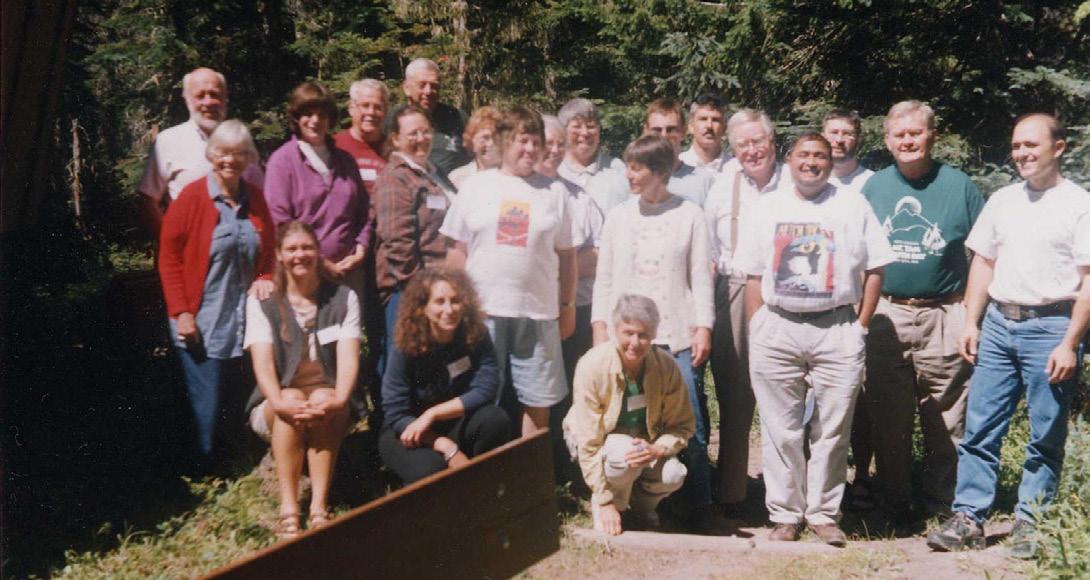 by Michael McCloskey, Senior Policy Advisor, FWOC
by Michael McCloskey, Senior Policy Advisor, FWOC
The years from 1950 through 1964 were pivotal for advancing wilderness legislation, and the FWOC was on top of these issues from the beginning. Back in 1950, Howard Zahniser (the Wilderness Society’s staff director and primary author of the 1964 Wilderness Act), came to speak at the annual conference of FWOC member organizations about the need for a wilderness bill and to get feedback.
The 1958 annual conference must have been one of our largest. It happened to be my very first conference, held on Hood Canal, and I was there representing the Obsidians from Eugene. I was assigned to the Resolutions Committee, serving with David Brower of the national Sierra Club. I saw L. A. Nelson, of the Mazamas, who had been its president in 1932 when he led the way in getting the FWOC started. National figures from the Wilderness Society and the National Parks Conservation Association were also there, as were regional representatives from the Forest Service and the National Park Service. Indeed, it was the most important gathering in the West for conservation leaders. The FWOC’s conferences became even more important as the 1960s began. Hundreds attended a session at Idylwild east of Los Angeles, especially from the Sierra Club.
As the number of issues exploded, national leaders such as Justice William O. Douglas pressed the FWOC to hire an organizer who could bring together and advise clubs on effective strategies.
Trails Club of Oregon’s Tyee Lodge, 2002.
In 1961, I was hired to play this role, which I did for four years before being hired by the Sierra Club.
In my role at the FWOC, I helped dislodge the Wilderness Bill in the district of the Interior Committee chairman. I also prepared a major report that sent proposals for North Cascades National Park on their way, with Brock Evans lobbying it through Congress. This work was supported by substantial donations from a member of the Mountaineers.
With all this important work, the number of FWOC member clubs grew, and we now exceed 50, including not only outdoor clubs but also conservation societies.
MAY/JUNE 2024 17
Above: Members of the Federation of Western Outdoor Clubs pose in front of the
Photo: courtesy of the Federation of Western Outdoor Clubs.
LEAVE NO TRACE
Words and illustrations by Ali Gray
We’ve all seen it—a pile of pistachio shells at the summit viewpoint, soggy toilet paper semi-hidden below a tree, a tent pitched too close to an alpine lake, the “shortcut” between trail switchbacks, hikers getting too close to a fawn for a photo, or the remains of an illegal campfire. People produce trash and make an impact on the landscape and its wildlife, there’s no way around that fact. But what we do with that trash and the way we make (or not make) our impact greatly affects those who come after us and the ecosystem we travel through.
“Leave no trace” is somewhat of a buzzphrase in the outdoor community, but what does it actually mean? How do we practice it? And why should we care?
THE 7 PRINCIPLES
As outdoor enthusiasts, we have an obligation to do what we can to be good stewards of the land we recreate on. Leave No Trace (LNT) is actually a 501(c)(3) nonprofit that works to provide guidelines and education about how to be that good steward. Here’s an overview of their 7 Principles, a fantastic framework to get us started and learn why these (yes, sometimes annoying or inconvenient) principles are oh so important. (Keep in mind that LNT guidelines can vary depending on where you are and what type of terrain you’re traveling through, so do some research about where you’re recreating before you head out.)
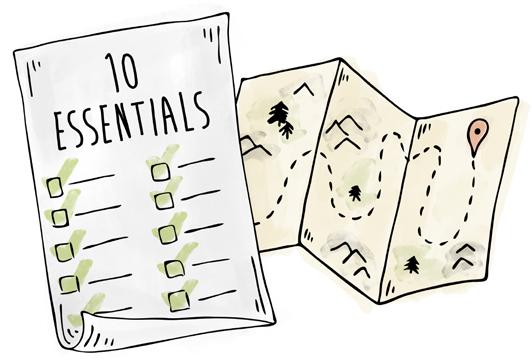
PLAN AHEAD AND PREPARE
Be safe and enjoy your time outside.
Do:
P Bring the 10 essentials (navigation, sun protection, insulation, illumination, first-aid supplies, fire, repair kit and tools, nutrition, hydration, and emergency shelter).
P Know the regulations and get proper permits.
P Camp in designated sites (where applicable), or arrive early enough to find an existing site (try not to make new ones!).
P Climbers: research the area’s ethics around designated parking and camping areas, approach trails, lowering vs rappelling, proper top-rope setup, seasonal wildlife closures, and rappel station locations—plan ahead to prevent needing to bail and leave gear on the wall or peak.
Don’t:
• Build cairns.
• Bring your dog if not allowed.
• Recreate in large groups (“large” could mean 12 in some areas but four in others, so make sure to look it up).
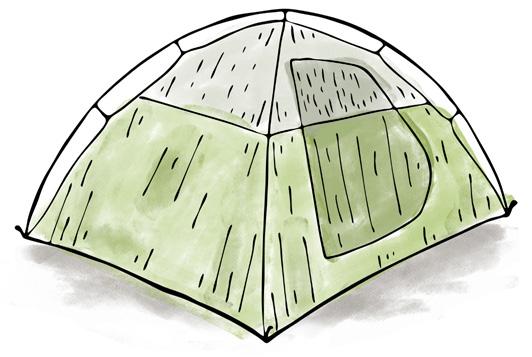
TRAVEL AND CAMP ON DURABLE SURFACES
Avoid damaging land, foliage, and waterways.
Do:
P Camp at least 200 feet from water, ideally where vegetation is absent, and keep your site small.
P Find (don’t make) a campsite.
P Walk on the designated trail whenever possible—help prevent erosion, damage to foliage, and the creation of user trails, especially in high-use areas.
P If off-trail, walk on hard surfaces like packed dirt or rocks as much as possible to avoid stepping on fragile vegetation or soils—snow is also a good walking surface.
P Climbers: use established approach trails and staging areas, minimize trampling vegetation or causing erosion at the base of the rock, and avoid using trees as anchors if possible.
Don’t:
• Walk around mud or puddles, widening the trail (using gaiters is a great way to stay clean and dry).
• Trample vegetation or fragile soils (especially in the alpine or desert).
18 MAZAMAS
• Cut “shortcuts” between switchbacks, or walk on lightly-used user trails (especially in high-use alpine camping areas) where damage is just beginning.
• Walk in single file while off-trail—spread out and disperse the impact (except when forced to walk on Cryptobiotic soil, where you should step in the same footprints as those in front of you).
• Walk on a muddy trail where you leave deep footprints that may dry out and leave the trail damaged.
• Enter small streams or lakes while wearing sunscreen, lotion, or insect repellant.

DISPOSE OF WASTE PROPERLY
Pack it in, pack it out.
Do:
P Leave trails and campsites cleaner than you found them—pick up any trash, including micro-trash (tiny pieces of garbage).
P Know how to go:
P If a bathroom (or outhouse, latrine, etc.) is available, use it.
P In heavy-use or fragile environments (like in the alpine, desert, or if there is only snow), use a WAG bag or other toilet kit and pack it out.
P In remote or less fragile environments, bury human (and dog) waste 6–8 inches deep at least 200 feet from water, camp, and trails (using a trowel to dig helps).
P Use small amounts of biodegradable soap, strain your dishwater (pack out the food bits), and scatter the water (not directly onto vegetation if possible) at least 200 feet from lakes or streams.
P Plan meals that minimize food waste/packaging and ease the clean-up process (plan to carry out things like grease or leftovers).
P Urinate at least 200 feet from water sources, trails, or campsites to avoid contamination and keep salt-hungry wildlife like mountain goats far from camp.
P Climbers: try not to spill chalk, use removable protection whenever possible, and, if necessary, urinate on the rock face rather than in a crack (eww).
Don’t:
• Litter! Even food scraps (think peels, shells, or little leftover bits) take a long time to disappear, and can harm the local ecosystem. Did you know that orange peels can take up to 2 years to decompose?
• Bury human waste and toilet paper in a too-shallow hole, where it’s easily dug up by wildlife. We’ve all seen gross damp toilet paper on the surface, and no one wants to find that!
• Bury wet wipes—they take up to 100 years to break down (even the biodegradable ones aren’t so good). Use toilet paper instead, or, even better, pack it out!
• Put your dog’s waste in its little bag, and then leave the bag along the trail—that’s just litter, and you’re not going to remember it on the way down.
• Burn trash or toilet paper.
• Wash dishes directly in lakes or streams.

LEAVE WHAT YOU FIND
Take only pictures, leave only footprints.
Do:
P Observe plants, rocks, and other natural or man-made historical/cultural objects, but leave them in place.
P Take a picture or make a sketch!
P Clean off your clothing and gear before and after entering a new area to help prevent the spread of non-native species.
P Follow local guidelines and best practices when foraging for edible plants.
Don’t:
• Pick flowers or take rocks.
• Build cairns, furniture, or other structures, or dig holes or trenches.
• Introduce or transport non-native species.
• Carve, saw, or nail into trees or rocks.
• Move rocks, logs, or other objects to construct a campsite—if you have to move it, replace it before leaving.
continued on next page
MAY/JUNE 2024 19

MINIMIZE CAMPFIRE IMPACTS
A tradition steeped in history or an out-of-control disaster?
Do:
P Consider using a stove for cooking or a lantern for light instead of lighting a fire.
P Pay attention to the fire danger of your area, and only light a fire if it’s allowed and the danger is low.
P Only make fires in established fire rings, or bring along a fire pan.
P Keep fires small, make sure all the wood fits in the fire ring, and keep sufficient water handy.
P Only use sticks and twigs you find on the ground.
P Burn everything to ash before putting the fire out.
P Buy local firewood instead of bringing it from far away, especially if it’s been sitting outside (it can carry lots of plant or animal non-native hitchhikers to the area).
P Completely put out a fire before leaving, and never leave a fire or coals (hot or lukewarm) unattended.
Don’t:
• Build new fire rings, or make existing ones larger.
• Use wood that doesn’t completely fit in the fire ring.
• Break or cut firewood from trees, alive or dead, standing or fallen.
• Light a fire if the fire danger is high, the surrounding vegetation is dry, there are trees or branches above, or it’s windy.
• Light a fire below a rock outcropping, which can get scarred with black for years to come.
• Use dirt to put out a fire, which can insulate the fire instead of putting it out—use water instead.
• Light a fire in an area (like the alpine or desert) where wood is scarce.
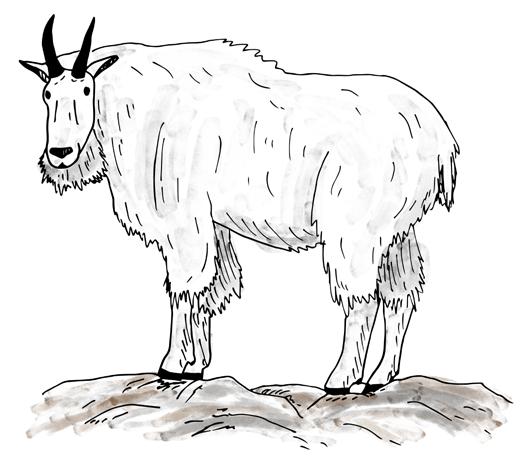
RESPECT WILDLIFE
They’re more afraid of you than you are of them—let’s keep it that way.
Do:
P Enjoy wildlife from a distance.
P Properly secure food and trash, and never leave it unattended (research the types of animals in the area to know the types of storage you’ll need—the locked car is a great place!).
P In bear country, know the regulations and store food (including smelly non-food items like toothpaste or soap) properly either in a bear canister or hung in a tree.
P Large predators are more dangerous when surprised or threatened, so make noise, don’t travel alone, and know when to back away slowly (don’t make eye contact, look big, and talk sternly to the animal), fight (mountain lions and black bears), or play dead (grizzly bears)—never run.
P Keep dogs on a leash to prevent them from chasing, digging up, or otherwise disturbing an animal, and leave the area if your dog is barking.
P Follow animal-specific closures or alert times, such as avoiding winter habitat or raptor nesting areas, and staying away from animals with young or during mating season.
Don’t:
• Follow or approach any animal.
• Feed any animal (intentionally or unintentionally)—this goes for urban critters like ducks or squirrels too!
• Let dogs chase any animal, or dig up a den or hiding place.
• Attempt to “help” any baby animals—mom is probably nearby, and some animals abandon babies who smell of humans.
• Attempt to help an injured or trapped animal on your own— alert the local authorities instead.
20 MAZAMAS
LNT, continued from previous page

BE CONSIDERATE OF OTHERS
Everyone just wants to have a good time.
Do:
P Protect the quality of others’ experiences—keep your voice down, use headphones for music, and give people space at overlooks, campsites, or other gathering places.
P Know the right-of-way on trails—everyone yields to horses and stock, bikers yield to hikers and runners, and downhill travelers yield to uphill travelers (unless they stop and say they need a break).
P When letting someone pass on the trail, find a durable place to step off.
P If passing someone going the same direction, ask if and when it’s ok to pass, and make sure they hear you—don’t just shove your way by.
P Make sure dogs are allowed in the area, and keep them on a leash wherever it’s required (or if someone asks you to).
P Remember that everyone has the right to recreate just like you do, so help them feel safe and welcome.
P Research the indigenous peoples and history of the land you’re recreating on, and respect tribal boundaries.
Don’t:
• Blast music on the trail or in camp, or make excessive noise during the night or early morning.
• Let your dog run up to other people or dogs, unless invited to do so.
• Hog entire overlooks or other gathering spaces—make sure everyone gets a place or a turn.
• Do or say things to make others feel unsafe or unwelcome, even if they might be recreating in a way different from you.
TAKING ACTION
The tips here are a quick overview of all the details Leave No Trace outlines on their website, lnt.org. Take a half hour to look over their guidelines (especially the pointers on disposing of waste). The guidelines also get updated periodically as the
science behind them changes or as the number of people outside continues to grow. Staying current is important! (For example, when my mom worked in the Grand Canyon in the 80s, it was common practice to put all, and I mean all, food waste in the river—oof!) And hey, I even learned a few things putting this article together.
I’ve always struggled with what to do if I see someone doing something I know to be “breaking an LNT rule”—do I silently walk on by or say something and risk confrontation? I don’t have a good answer, but I think the best place to start is following the 7 Principles ourselves. This way others can see what we’re doing and maybe learn something. If you see someone who seems unsure or open to input, perhaps say something. If the situation seems unsafe or just “off,” keeping quiet and moving on may be the best call. In any case, enter any situation with a kind attitude and an educational focus—we’re all outside to have a good time, and don’t want to be talked down to or yelled at.
Yes, I know learning about “what not to do” in the backcountry (or in our urban or urban-adjacent natural areas) can be boring or even off-putting, but if we follow these guidelines and help spread knowledge about them, we can help our beloved recreation areas remain healthy and beautiful for years to come.
DID YOU KNOW?
The Mazamas published a flyer titled “Pardon Me—You’ve Dropped Something!” sometime before 1957 (exact date unknown), a good decade or two before the Leave No Trace movement began taking root, not becoming the official nonprofit organization we know today until 1994. Here’s the content of the flyer:
“This is your Pacific Northwest. Its mountains, riverbanks, highways, parks, and beaches are showing signs of the carelessness of those who use them for camping, climbing, picnicking, hunting, and fishing. Did you leave a littered campground or did you deposit your trash in the receptacle provided for it? Did you leave the remains of your lunch on the mountain top? Did you drop gum and candy wrappers on the lovely forest trail? A forest camp or state park is wonderful for a picnic, but not for the next fellow if he has to clean up the mess you left! You may have had good hunting and fishing, but the bears had fun too—scattering your garbage around! Those tin cans and broken bottles don’t help the scenery and you might want to come back next year. Our national parks were established to preserve the scenery for all time, but some people don’t seem to get the idea! Do you throw banana peels, paper, and bottles out your car window, or do you carry a litterbag to take care of trash? Did you leave an untidy beach? What will the seagulls think of you? No forest creature will ever say, as you walk or drive away, ‘pardon me, you’ve dropped something!’”

MAY/JUNE 2024 21
MAZAMA CLASSICS
For members with 25 years of membership, or for those who prefer to travel at a more leisurely pace.
We lead a wide variety of year-round activities including hikes, picnics, and cultural excursions. Share years of happy Mazama memories with our group. All ages are welcome to join the fun.
CONTACTING THE CLASSICS
Contact the Classics Committee Chair, Gordon Fulks, at classics@mazamas.org.,
SUPPORT THE CLASSICS
The Classics Committee needs a volunteer to put more content in our column on a quarterly basis. We want to document past Classics events and make sure that our postings to the web are current and complete. More generally, there is always work to be done on the committee.
CLASSICS COMMITTEE MEETING
Our meetings are the fourth Monday of every other month at 11 a.m. on Zoom. Email classics@mazamas. org for link information.
CLASSICS ANNUAL PICNIC
The Classics Committee is pleased to announce that Dick and Jane Miller will again host their annual picnic on Saturday, July 6 at their home. As in previous years, this is a potluck where everyone is asked to bring a main dish, side dish, salad, or dessert suitable for six people. The picnic begins at noon, and lunch is at 1 p.m.
Event: Annual July Picnic
Date: Saturday, July 6, 2024, at noon
Hosts: Dick and Jane Miller
Address: 17745 SW Cooper Mountain Lane, Beaverton, Oregon
SUCCESSFUL CLIMBERS
February 3, 2024–Mount St. Helens, Swift CreekWorm Flows (No Permit). Darren Ferris, Leader; Evan Conway Smith, Assistant Leader. James Taylor, Douglas Filiak, Stefan Butterbrodt.
February 23, 2024–Mt. Hood, Devil’s Kitchen Headwall. Pushkar Dixit, Leader; Chris Jay Burreson, Assistant Leader. Rob Sinnott, Yukti Aggarwal.
February 23, 2024–Mount St. Helens, Swift CreekWorm Flows (No Permit). Sergey Kiselev, Leader; Wim Aarts, Assistant Leader. Jonathan Watkins, Gary Riggs, Stephanie Mackenzie, Benjamin Schmidt.
February 24, 2024–Mount St. Helens, Swift CreekWorm Flows (No Prmit). Joe Preston, Leader; Heather Johnston, Assistant Leader. Edward Decker, Christian Frees, Zachary Warres, Nicholas Peeters, Heather Nesheim, Mike Quigley, Katherine Peters, John Sullenbarger.
March 8, 2024–Mount St. Helens, Swift Creek-Worm Flows (Skis-Splitboard Only). Pushkar Dixit, Leader; Rob Sinnott, Assistant Leader. Kathrin Dragich, Leah Brown.
March 30, 2024–Mt. Hood (Wy’east), South Side. Sohaib Haider, Leader; Kyle Stephen DeHart, Assistant Leader. Nikolay Roshet.
March 31, 2024–Mt. Hood (Wy’east), South Side (Skis-Splitboard Only). Pushkar Dixit, Leader; Rob Sinnott, Assistant Leader. Gordon Wilde, Matt Mudrow, Finley Tevlin, Kathrin Dragich, Ashlin Aronin.
Contact us to learn more about advertising in the Mazama Bulletin! mazama.bulletin@ mazamas.org
22 MAZAMAS
YOUR AD HERE!
JOIN US FOR BASE CAMP!
We’re thrilled to bring Evening Programs back to the Mazama Mountaineering Center! Hone your skills in trailside flora identification, learn about local environmental stewardship efforts, and sit back and relax for a range of documentary films highlighting the delicate balance of adventure and advocacy in the outdoors. Evening programs run October–May and are free and open to the public.
UPCOMING EVENTS FOR THE MONTH OF MAY
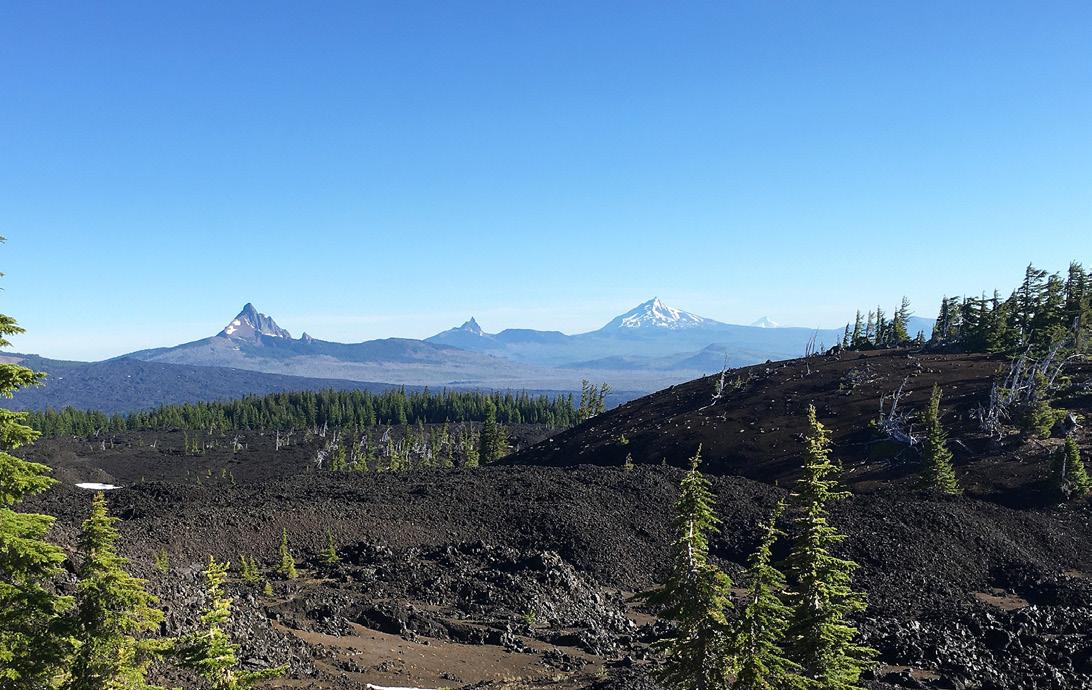
Author William
L. Sullivan, New Hikes in Oregon
Date: May 1
Time: 6:30 p.m.

Reimagining Wildfires–Movie Screening & Expert Panel
Date: May 15 Time: 6:30 p.m.
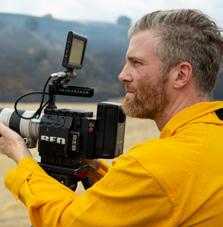
Questions? Comments? Reach out to programs@mazamas.org

MAY/JUNE 2024 23
WHAT’S AHEAD FOR THE MAZAMA BULLETIN ?
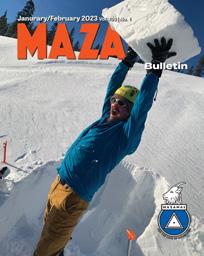
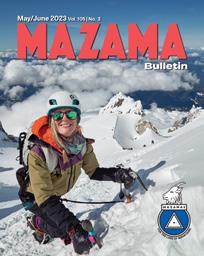
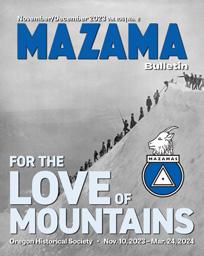 by Mathew Brock, Mazama Bulletin Editor, and Darrin Gunkel, Publications Committee Chair
by Mathew Brock, Mazama Bulletin Editor, and Darrin Gunkel, Publications Committee Chair
For over 100 years the Mazama Bulletin has been a consistent presence in the lives of Mazama members. Over the years the Bulletin has evolved from a monthly newsletter into a bimonthly magazine. The guiding principle for the bulletin has always been capturing “Mazamas doing Mazama things,” and beyond that, sharing information and activities that are of interest to the membership. And the Bulletin has grown under that guiding principle from four pages in 1923 to an average of 40 pages today. Longtime readers can likely recall several masthead and editorial changes over the years. Going into our 101st year, the Mazama Bulletin is evolving again.
For those of you who remember paper climb cards, you’ll recall that for several years the Bulletin had a consistent cycle of themed issues. January often celebrated our many volunteers, while April published the climb schedule for the coming season. An issue focused on hiking usually followed in May, while the August issue was often about our many educational programs. September usually highlighted various stewardship or conservation topics, while December celebrated winter adventures.
The Publications Committee and I have been in discussions for several months now on how to refresh the Bulletin to better reflect the evolving nature of the Mazamas as an organization and as a community. To that end, we’re transitioning back to themed issues beginning next month. The July/August Mazama Bulletin will celebrate the 30th anniversary of the Mazama Trail and all things related to hiking. We’re looking at an issue dedicated to rock climbing for September/October, and a return of winter activities for November/December. Looking further ahead we’re mulling themed issues focused on fitness and nutrition, summer adventures, education, and stewardship/conservation. And much like we did with the Arts (March/April 2023) and For the Love of Mountains (November/December 2023) issues, we’re exploring


special issues around outdoor skills, wildlife watching, outdoor photography, and adventure cuisine, among other ideas. And finally, in the coming months you’ll also likely see some other changes, from tweaks to the masthead and style to how the Bulletin looks and feels in your hands.
But we cannot do this alone. To continue to meet our guiding principle of documenting and celebrating “Mazamas doing Mazama things,” we need you, our readers and members, to step up and contribute. You are the Mazamas. Your stories, your adventures, and your knowledge define the organization. The Bulletin should represent that. With your help, we can produce a better product for you. The Publications team is a talented group of writers, editors, and you-can-do-it! advocates willing to help you transform your knowledge and narratives into feature content to be shared with your fellow Mazamas. What will we publish? Just about anything of interest to the organization: tips and tricks, stories of trips taken, reporting on Mazama events, profiles of people, poetry, news from the climbing world, and on and on.
There are two ways that you can get your ideas into print. The first is to tip off our crack team of writers about your idea and let us do all the heavy lifting. The second is to share with us a draft of your contribution, and we can help polish it up. Our staff includes experienced editors capable of working with you to craft top-notch writing. Reach out to publications@mazamas.org to get started.
24 MAZAMAS
YOUR
HERE! Contact us to learn more about advertising in the Mazama Bulletin! mazama.bulletin@ mazamas.org
AD
ROUND THE MOUNTAIN
AUGUST 30–SEPTEMBER 2, 2024
 by Mazama Trail Trips Committee
by Mazama Trail Trips Committee
This Labor Day weekend, join the 16th annual Round the Mountain hike of the Timberline Trail around Mt. Hood with only a day pack! Each day you’ll be shuttled to trailheads accessing the trail before returning each night to the historic Mazama Lodge in Government Camp to enjoy great food, hot showers, and a comfortable place to sleep (and hopefully a few good stories from the day).
You’ll arrive at the lodge on the evening of Friday, August 30 for dinner, a good night's sleep, and orientation. On Saturday, August 31, and Sunday, September 1, you’ll wake bright and early, have a hot breakfast, and head to the day’s hike with your experienced hike leaders and group.
Groups are limited to 12 hikers in total and will be organized by pace, so we will have groups for fast, average, and more moderate hiking speeds.
On Monday, September 2, you’ll again have a hot breakfast before hiking your final trail segment and then be transported back to the lodge. Transport to and from the Portland International Airport is available, and is included in the price!
All meals are provided, including pack lunches, along with three nights of lodging at the Mazama Lodge (bring your sleeping bag and pillow) and van shuttle transport to and from all trailheads.
Don’t miss out on this great event! For more information and to register, visit mazamas.org/rtm.
Questions? Email us at rtm@mazamas.org.
What: Round the Mountain 2024
When: August 30–September 2
Cost: $700 members/$800 non-members Register: www.mazamas.org/RTM
MAY/JUNE 2024 25
LOOKING BACK
by Mathew Brock, Mazama Library and Historical Collections Manager
Welcome to “Looking Back,” an occasional column that delves into the rich history of the Mazamas. As your guide through the annals of time, we’ll embark on a journey back 25, 75, and 125 years to revisit the remarkable events, happenings, and adventures that have shaped the organization’s legacy. From awe-inspiring mountaineering triumphs to community milestones, this column serves as a nostalgic look back at the moments that have shaped the Mazamas.
25 years ago (1998)
A tragic incident occurred on May 31, 1998, during a graduation climb for the Mazama Basic Climbing Education Program on Mt. Hood. A large slab avalanche struck a rope team of three climbers on the West Crater Rim route, sweeping them down a 45–50 degree slope through the Hot Rocks area before coming to a halt between Crater Rock and Castle Crags. One climber died of traumatic injuries from the fall, while another sustained a fractured pelvis and the third a broken ankle. The climb leader was also briefly caught, injuring an ankle and shoulder.
Disturbingly, earlier that day at Timberline Lodge, a hand-written sign in the Forest Service Climber’s Register had alerted the group to “High Avalanche Hazard!”—only the second such warning posted in seven years. This unusually high risk resulted from heavy snow loading the previous week, with an old frozen crust beneath fresh snow exacerbated by rapid warming at the time of the avalanche’s release. The party’s slow pace unfortunately had them traversing the sun-exposed and destabilized West Crater Rim slope well after warming had occurred.
Several secondary factors were identified as contributing to the tragic outcome. With no assistant leader of sufficient experience present, the decision to proceed on the West Crater Rim route went unquestioned. The roped team travel may have worsened the severity of injuries, and the vague warning sign failed to clearly communicate that the avalanche danger still applied. Moreover, the review found a general lack of awareness among climbers on Mt. Hood that day about the potential for large slab avalanches “even on nice days.”
This sobering 1998 incident prompted deep self-reflection within the organization. The Mazamas engaged Ian Wade, then director of Adventure Safety
International, to conduct a comprehensive risk management assessment over three months in 1999. Wade immersed himself in Mazama operations—interviewing committee chairs and climb leaders, participating in snow, rock, and leadership training, sitting in on meetings of the ad hoc Incident Response Review Committee, and thoroughly reviewing policy and procedure manuals.
The resulting 41-page “Wade Report,” presented to the Executive Council in June 1999, contained a wealth of findings and recommendations that reverberate through the organization to this day, even if their specific origins are lost to institutional memory. Key recommendations that were implemented included establishing a leadership development program to train new and existing climb leaders in current best practices, forming a critical incident stress debriefing group to assist those who have experienced trauma, and developing a detailed action plan for organizational response to serious accidents and incidents.
The Mazama Leadership Development course, Risk Management Committee, Critical Incident Response Committee, and comprehensive Critical Incident Response Plan all directly arose from the Wade Report’s counsel. While the tragedy of 1998 was profoundly difficult, it catalyzed an organizational commitment to rigorously upholding safety standards and practices befitting the inherent risks of mountaineering activities.
75 years ago (1948)
The May 1948 edition of the Mazama Bulletin opened with an amusing article titled “The Cynic’s View of Mountaineering” by Carl P. Richards. In it, Mr. Richards recounts how a friend who had moved from the Pacific Northwest reacted scornfully when sent photographs of the snow-capped Cascade peaks. Mr. Richards had explained to his friend that he was
part of a mountaineering group that climbed those mountains. However, the friend’s reply makes it clear he viewed such endeavors as uncivilized and irrational— acquaintances who “risk their necks” scaling dangerous, snow-covered summits just to turn around and come back down. The friend felt admitting to having such friends would tarnish the reputation of Pacific Northwesterners, whom he had represented to his new friends as “intelligent, well-trained, and respectable” people. Despite this perspective on their passion, Mr. Richards lightheartedly predicted that mountaineers would continue to climb and explore those peaks nonetheless.
Just a month later, the June bulletin covered a significantly more serious matter facing the organization. The previous year, despite boasting its largest membership ever, the Mazamas found itself in difficult financial straits. Income from initiation fees and dues fell $1,500 short of the $5,000 needed annually for operating expenses like rent, publications, postage, and general operations. A special committee was formed in March to address the shortfall. The committee diligently explored cost-cutting measures. While investigating cheaper rental options, they found that decent non-fireproof spaces far from downtown offered little savings and would require sacrificing space for storage and meeting halls. Reducing publication expenses was also looked at, though not at the cost of compromising the high standards built over 40 years. Ultimately, the main proposed solution was to grow the membership.
Taking the 1,600-member Seattle Mountaineers as a model, the committee expressed confidence that given Portland’s wartime population growth, the Mazamas could easily attract over 1,000 members as well. To this end, they recommended reinvigorating the Membership Promotion
26 MAZAMAS
Committee to actively recruit new members.
Coupled with enforcing spending controls, the committee further proposed increasing certain fees and dues— specifically, raising initiation fees from $3 to $5, resident dues from $5 to $6, and spouse/family dues from $1 to $2, while keeping non-resident dues at $4 and reducing 25-year member dues from $5 to $4. Amendments to the bylaws reflecting these new rates were presented to the membership. The multi-pronged approach of an expanded membership base, higher fees and dues for most categories, and spending controls were projected to restore the organization’s budget. Clearly, the leadership saw increasing the organization’s membership as key to balancing the budget.
125 years ago (1898)
The Mazamas did not publish an Annual in 1898, and the birth of the Mazama Bulletin was still 25 years away. Looking back at the minutes of the Mazama Executive Council, as the Board of Directors was known at the time, shows that in May, the council members were still hard at work on the proposed constitution of the Mazamas. The minutes report that a copy of the constitution was sent to the Seattle Mazama contingent for their review, but no response was received. By June, planning was underway for that year’s Annual Outing to Mount St. Helens. The efforts were headed by L.L. Hawkins, as a committee of one.
SUNDAY SKILLBUILDERS: SOMETHING FOR EVERYONE
by Mathew Brock, Mazama Library and Historical Collections Manager
In early 2023, longtime Mazama members John Godino and Andy Nuttbrock started the Sunday Skill-builders to provide affordable, bite-size learning opportunities for our members. The one-day courses cover a variety of topics and have quickly become very popular. Over the past year, more than 500 people have participated in the classes.
The skill-builders cover a wide range of topics, from practical self-rescue to cleaning sport climbing anchors. The most popular class has turned out to be glacier travel and crevasse rescue, prompting the repeat of that class four times per year now. Other classes include mechanical advantage hauling, map and compass navigation, and digital trip planning, to name a few.
According to Godino they try and offer something for just about anyone, from beginner to intermediate to advanced. The idea is that everyone can learn and improve their skills, so the classes are designed for easy access. They are held on Sundays, a day most people are available, and they are inexpensive, at only $35 for members. In addition, classes are held in town, at the Mazama Mountaineering Center, and don’t require driving to an offsite field location. And the classes cycle every six months, so if you miss a class, you won’t have to wait long for it to come back around.
Looking ahead to the rest of 2024, here are the upcoming Sunday Skill-builders for the rest of the year:
■ July 14: Sport Climbing Anchors 101
■ July 28: Advanced Anchors
■ Aug 11: Mechanical Advantage in Self Rescue
■ Aug 25: Glacier Travel and Crevasse rescue
■ Sept 8: Rappel 101
■ Sept 22: Advanced Rappel
■ Oct 13: Map, Compass, and Gaia GPS 101
■ Oct 27: Digital Trip Planning
■ Nov 20: Aid Climbing 101
■ Nov 24: Practical Self Rescue
■ Dec 8: Glacier Travel and Crevasse Rescue
For more information and to sign up, visit bit.ly/MazSundaySkillBuilders
MAY/JUNE 2024 27
BOARD OF DIRECTORS MINUTES
FEBRUARY, 6, 2024
Attending: Greg Scott, President; David Urbaniak, Vice President; Liz Crowe, Treasurer; Matthew Sundling, Secretary; Charles Barker, Chris Jaworski, Claire Tenscher, Debbie Dwelle, Marty Hanson; Staff: Rebekah Phillips, Executive Director.
WELCOME & CALL TO ORDER
■ The meeting was called to order at 6:09 p.m. by President Greg Scott.
■ A quorum was present.
MEETING AGENDA
Meeting minutes approval
■ Prior meeting minutes approval requires a vote.
■ Vote on public and executive session meeting minutes. Motion to approve Nov 2023 and Dec 2023 set of meeting minutes:
□ Motion (Chris J. ), second (Liz C.), 6 in favor, 0 against, 3 abstained (Martin H., Matt S., Debbie D.).
■ Note: there was no Jan 2024 meeting besides the January Board retreat.
ELECTION OF BOARD OFFICERS
■ Vote on board officers. Motion to elect Matt S. as Secretary.
□ Motion (Charles B.), second (Liz C.), 8 in favor, 0 opposed, 1 abstained (Matt S.).
■ Officers continuing in their roles: Greg S. as President, David U. as Vice President, Liz C. as Treasurer.
CONFLICT OF INTEREST DISCUSSION
■ Vote on conflict of interest. Motion to waive a conflict of interest between board member Chris J. and the Mazamas between his role as a board member and anticipated role as lodge consultant. To the extent the board needs to make decisions on lodge spending, use, staffing, and budget, and the Mazama annual budget, while the contract for consulting is in effect, Chris J. will not be allowed to vote on those topics. If the board discovers an alternative arrangement for lodge management it must be brought to the board for consideration.
□ Motion (Greg S.), second (David U.), 8 in favor, 0 against, 1 abstained (Chris J.).
EXECUTIVE
DIRECTOR REPORT
■ Rebekah addressed staffing and personnel shortage issues, noting recent adjustments to alleviate shortages. The newly created Finance and Administration Manager position has potential candidates, with an offer sent out on February 7, 2024. In response to staffing challenges, volunteers are now assisting with front desk duties, including answering phones and managing office messages. Special recognition was given to Marty Scott for volunteering on Tuesdays and Scott Stevenson on Thursdays. Despite staffing challenges, program revenue remains on track, reflecting the success of various programs and their respective revenue schedules. Rebekah provided updates on membership and program enrollment, highlighting that the organization has achieved 92 percent of its membership target and is on track to meet its revenue goal.
TREASURER’S REPORT
■ Nothing to report.
COMMITTEE REPORT(S)
■ Nothing to report.
LIAISON PROPOSAL
■ Proposal: To appoint a board member as a liaison to supplement the Executive Director’s role as the primary point of contact for volunteer leaders, including chairs and program coordinators. The liaison’s responsibility would be to offer an additional communication channel, aiming to enhance redundancy and distribute workload.
CONTRACT DISCUSSION
■ Contract between Chris Jaworski and the Mazamas. With Chris J. serving as a paid consultant for work with the Mazama Lodge, the board is tasked with voting to waive the conflict of interest. However, Chris J. will continue serving on the board until the contract is reviewed and approved. Guardrails are established to ensure that Chris J. abstains from voting on matters involving material use, major applications, budget allocation, spending, and staffing related to the Lodge. Questions regarding the board’s due diligence concerning this
conflict were addressed by Greg S., who explained the extent of the research and exploration conducted. The Lodge Advisory Committee initiated an RFP process from April 25, 2023, to August 2023, which yielded a limited response. During the due diligence phase, Chris J. was involved in overseeing the process, ensuring transparency and adherence to protocols. While Chris J. facilitated the process objectively, the bulk of the work was conducted by the Lodge Committee, primarily led by Brook Harris and Michael Fusciolo.
■ Elizabeth English, a lawyer, drafted a contract between Chris J. and the Mazamas. Chris J. provided additional insights into their proposal and the contract. These details outlined that lodge staff would consist of volunteers while also ensuring the ongoing health and safety of the lodge. A revised version of the contract will be distributed, and feedback on it is requested by February 9, 2024, at 5 p.m.
FACILITIES ASSET PLAN AND RISK MANAGEMENT DISCUSSION
■ The board discussed various facilityrelated issues, particularly those arising from a recent ice storm. Discussions also touched on the need for continuous assessment and adaptation to address emerging facility-related concerns. The board engaged in a comprehensive discussion on developing a facilities asset plan and risk management strategy to maintain and enhance the organization’s infrastructure while mitigating potential risks. They explored the need for defining clear objectives, monitoring mechanisms, and policies to address facility-related challenges and ensure operational resilience.
WEBSITE IMPROVEMENTS
■ The board engaged in discussions concerning enhancing the user experience on the organization’s website. They emphasized the importance of improving functionalities such as badge management and discussed allocating resources towards these enhancements. Furthermore, there were considerations about involving specific team members,
28 MAZAMAS
such as Rebekah P. and Debbie D., in this potential project.
OVERSIGHT OF INVESTMENT FUNDS
■ There was a detailed discussion regarding the oversight of investment funds, with the board focusing on optimizing returns while managing associated risks. Strategies to ensure prudent investment decisions, diversification, and adherence to investment policies were deliberated to safeguard the organization’s financial assets and support its long-term goals.
RESEARCH GRANT FUNDING
■ The board engaged in a discussion concerning the allocation of restricted funds specifically designated for research grants. Recognizing the importance of supporting research endeavors aligned with the organization’s mission, they reaffirmed their commitment to reengage with these grant offerings.
BOARD PRIORITIES AND NEXT STEPS
■ Rebekah P. will communicate the liaison role to the committee chairs at the Committee Chair Orientation.
■ Rebekah P. will circulate the corrected contract and the sensitivity analysis.
■ Matt S. will work with David U. on the AIARE program for Winter 2024–2025.
■ Rebekah P. will work on partner development on Mt. Hood.
■ David U. will evaluate the user experience and identify areas for improvement.
■ Debbie D. will help with evaluating the user experience and identifying areas for improvement.
■ Greg S. will follow up with Claire T. to discuss the goals and objectives agreed upon during the meeting because Claire T. had to depart early.
EXECUTIVE SESSION
■ Executive session call to order 8 p.m., adjournment 8:14 p.m.
MARCH 5, 2024
Attending: Greg Scott, President; David Urbaniak, Vice President; Liz Crowe, Treasurer; Matthew Sundling, Secretary; Charles Barker, Chris Jaworski, Claire Tenscher, Debbie Dwelle, Marty Hanson; Staff: Rebekah Phillips, Executive Director.
WELCOME & CALL TO ORDER
■ The meeting was called to order at 6:02 p.m. by President Greg Scott.
■ A quorum was present.
MEETING AGENDA
■ Meeting minutes, vote on public and executive session meeting minutes.
■ Motion to approve February 2024 meeting minutes:
□ Motion (Debbie D.), second (Liz C.), 7 in favor, 0 against, 1 abstained (Claire T.). The motion passed.
EXECUTIVE DIRECTOR REPORT
■ Mathew Brock’s lantern light show with the historical society was a success, selling out through the Oregon Historical Society (OHS) marketing channels. Rebekah is advocating for a second showing in the coming weeks, emphasizing Mathew’s reliability and excellence.
■ Brendan Scanlan’s meeting with knowledgeable volunteers to address IT concerns, particularly regarding Salesforce, promises enhancements to the website and a reduction in hands-on workload for Mazama staff, with future plans for automated email communication.
■ Rick Craycraft was commended for his consistent morale support and overall excellent contributions, while Jeff Hawkins, recognized as an unofficial staff member, has been instrumental in supporting facilities.
■ Cathy Dow, the new Finance and Administration Manager, has already hit the ground running, working in the office Tuesdays through Thursdays, while the screening process for the development position is ongoing.
■ In other updates, Oakshire Brewing will be hosting a benefit for the Mazamas on March 19, with 10 percent of food sales and $1 per pint donated to celebrate the organization’s mission.
■ Additionally, there was a call to action regarding diversity, equity, and inclusion (DEI), emphasizing the need for leadership, a strategic plan, and a roadmap to integrate DEI into operations for long-term sustainability and meaningful impact.
TREASURER’S REPORT
■ The January 2024 update marks the first report since October 2023. We began by reconciling receipts and catching up on the current financial status. Notably, there is a significant cash variance, with an excess compared to the budget. As of February, there is $213,000 cash on-hand, excluding pledges. Our goal is to maintain 12 weeks of cash on-hand, amounting to $125,000, which we are currently achieving. Moving forward, it is imperative to re-forecast for the remainder of Q1 and Q2. Despite these challenges, it is encouraging to start 2024 on a positive note.
COMMITTEE REPORT(S)
■ Nothing to report.
LODGE CONTRACT
■ Some members require additional time to review the material concerning the contract with Chris J. and are not ready to vote. Therefore, it has been proposed to delay the voting process and instead conduct it via email later this week. All necessary documents, including the contract, supporting materials, budget, and red line material, have been provided to board members for their thorough review and consideration. Vote delayed to email.
RESTRICTED AND “RESCUE INSURANCE” FUNDS
■ In 2022, discrepancies in the balance of restricted funds prompted the need for clarity regarding donors, restrictions, and the purpose of these funds. By the end of 2023, significant progress was made in updating this information. Currently, there are $335,000 in restricted assets, with 19 percent allocated for conservation efforts, 51 percent for expeditions (with potential additional contributions from the Bob Wilson Estate), and the remainder comprising
MAY/JUNE 2024 29 continued
on next page
BOARD OF DIRECTORS MINUTES
Board minutes, continued from previous page
various restricted funds, such as those designated for the library, lodge roof repair, and volunteer appreciation.
■ Two funds of particular interest include the Chaitanya Sathe Fund, established through a fundraising effort by the family, totaling about $15,000, with $7,500 already allocated to meet the fund’s restrictions. There has been an acknowledgment to convert the remaining balance associated with this fund to unrestricted funds. Additionally, there is $19,000 in restricted funds allocated by the board for Mazamamanaged “rescue insurance.” Although there is an existing policy in place (albeit outdated by several years), there is a suggestion to reconsider this aspect. It is proposed to conduct further research, including a side-by-side comparison of adding rescue insurance to our policy versus remaining self-insured, before making any decisions on this matter.
CONSERVATION COMMITTEE GRANTS
■ Request from Conservation Committee to approve to consider balancing Ellis Trust and Oberteuffer Fund, and make up to $12,500 in total grant awards for 2024 available, $2,500 max per award. No change to qualifications. Basically reboot these grants. This would release restricted funds for 2024. They would present at the May 2024 meeting about the awardees.
■ Vote on releasing $12,500 from conservation restricted funds for the Conservation Committee for use to potentially award conservation grants–maximum of $2,500 per grant.
□ Motion (Matt S.), second (Chris J.), 7 in favor, 0 against, 1 abstained (Claire T.). The motion passed.
RISK MANAGEMENT COMMITTEE
■ Petra LeBaron-Botts and Joe Preston, co-chairs of the newly reconstituted Risk Management Committee (which is likely to be renamed soon), will collaborate as a subcommittee with the Climbing Committee given their inherent mission overlap. The primary focus of this subcommittee will be technical analysis
to enhance the ongoing improvement of climbing and risk-related activities within the Mazama community. Monthly meetings are scheduled to ensure regular progress and coordination. It is noteworthy that some members with professional expertise will actively contribute to the committee’s objectives and initiatives.
MISCELLANEOUS TOPICS
■ AAC Gala: The American Alpine Club (AAC) is hosting a fundraising gala in Los Angeles, scheduled for April 26 to 28. Board members have been invited to attend, noting that there will be an admission cost as well as potential travel expenses.
■ Loco por la Aventura: Anibal Rocheta presented partnership opportunities with his guiding company, Loco por la Aventura. There are multiple potential avenues for collaboration with this nonprofit, which aligns with the goals of the Mazamas. Loco por la Aventura offers outdoor activities and serves the Latinx community, addressing barriers that affect this demographic.
■ Board goals: Although it is early in the year, there was a reminder to remain productive and focused on making progress. Board members were encouraged to identify any support they may need and to communicate any barriers they are experiencing.
EXECUTIVE SESSION
■ Executive session call to order 7:03 p.m.
ADJOURNMENT
■ The meeting was adjourned at 7:29 p.m. by President Greg Scott.
30 MAZAMAS
SAYING GOODBYE
ROBERT STAYTON
MARCH 24, 1943–FEBRUARY 19, 2024
Bob loved trekking and fishing, and climbed many peaks in his life. For many years, Bob served as the chair of the Mazama Lodge Committee.
MARY LUCILE STADLER
MARCH 29, 1940–APRIL 1, 2024


Mary Lucile Stadler (née Loomis) was born on March 29, 1940, in Portland, Oregon to Elizabeth (Gabler) and Charles Loomis. Mary graduated from Grant High School in 1958. She then attended Oregon College of Education (now Western Oregon University) for two years. She married David Carleson in March of 1960. They had three children, Kristine (Carleson) Eberle, Gwen (Carleson) Gamble, and Lisa (Carleson) Boyd, and then divorced in 1979. In 1995 Mary married Lawrence Stadler. Avid adventurers with a mutual love of the outdoors, they spent their honeymoon hiking the famous Chilkoot Trail in Alaska.
Mary was active in the Mazamas, serving as a climb leader, trail trips leader, Nordic ski school leader, and Outings leader. She also served on numerous committees including the council and Lodge and Climbing Committees. She summited over 100 peaks, including the major peaks in the Northwest and northern California plus some in the Swiss Alps. Her Mazama awards include the 16 Major Northwest Peaks, Hardesty Cup, 1,000mile Trail Trips, and 15-point Climb leadership. Mary loved the outdoors, from hiking, climbing, canoeing, and whitewater rafting. She spent many vacation days canoeing rivers throughout Oregon with her young family. Later in life, she took on the hardier adventure of whitewater rafting, including extensive trips on the Deschutes, Rogue, Main Salmon, and Colorado Rivers.
In 2004 Mary and Larry moved to Redmond, Oregon, where they had a house built on the banks of the Deschutes River. From their house, Mary lovingly viewed the Central Oregon Cascades. She continued hiking and climbing and took up square dancing. Mary and Larry also traveled the world together. They trekked in Tibet, visited Antarctica, hiked and traveled throughout Europe, and visited Africa, South America, Asia, the South Pacific, Hawaii, Canada, Australia, and New Zealand. Mary set foot on and explored all seven continents. She took up cruising and logged over 650 days at sea. Most recently she enjoyed a final cruise in Alaska with her family.
Mary was also an advocate for good health and was a 20-year volunteer for an Oregon Health Sciences University study on aging. Mary’s zest for adventure is her legacy which she has passed down to her children and grandchildren. See the world, live life to the fullest, and when given the opportunity, go for the adventure!
OWEN W. BENTLEY
APRIL 1, 1927–MARCH 5, 2024
Owen W. Bentley, Jr., a longtime member of the Mazamas, passed away on March 5, 2024, at the age of 96. Owen joined the Mazamas in 1966 and quickly became an active and accomplished climb leader.

Owen earned his Guardian Peaks Award in 1967 and his Oregon Peaks Award the following year in 1968. He went on to earn his 16 Northwest Peaks Award in 1974. His passion for mountaineering was evident through his years of service as an active Mazama climb leader from 1970 to 1976, leading ten climbs during that time. Before becoming a leader himself, Owen gained valuable experience as an assistant climb leader starting in 1968, assisting on six climbs under the mentorship of Mazama members Ed Johann, Ken Winters, and Ray Snyder. His dedication was recognized with the 10-Point Leadership Award in 1970.
In addition to his climbing achievements, Owen served on the Mazama Climbing Committee from 1969 to 1975, helping shape the organization’s climbing policies and activities during that period.
Owen’s love of the outdoors extended beyond mountaineering to cross-country skiing, bicycling, hiking, camping, and hunting— activities he shared with his wife Ruth and three children. His passion for adventure and the natural world will be dearly missed by the Mazama community.
LOU WHITTAKER
FEBRUARY 10, 1929–MARCH 24, 2024
Honorary Mazama member Lou Whittaker passed away on March 24, 2024, from complications due to congestive heart failure. Mr. Whittaker climbed all of the major peaks in the northwest, including Mt. Rainier more than 250 times. Outside of the Northwest, he climbed K2, led the successful China/Everest Expedition in 1984, and in 1989, led the first successful American team onto the North Face of Mt. Kanchenjunga, the world’s third highest mountain. He was co-founder, along with his twin brother Jim Whittaker, of the Rainier Mountaineering, Inc. guiding service.
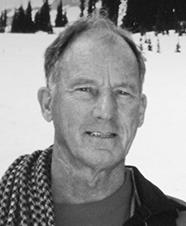
Lou and Jim began climbing at the age of 12. By 18, Lou had climbed all the major mountains in Washington. Together, the brothers taught climbing skills to the famed 10th Mountain Division during the Korean War. When not climbing, Mr. Whittaker researched and tested climbing and outdoor gear, and worked as a design consultant for a major gear manufacturer. He was active in many charitable organizations, including fundraising for “The Climb,” a benefit for asthmatic children. He was a board member of many organizations, including the Outdoor Coalition of America, Walkways Center, and Mountain Rescue Council.
MAY/JUNE 2024 31

32 MAZAMAS Mazama Periodical Postage Paid in Portland, Oregon Mazamas® 527 SE 43rd Ave. Portland, OR 97215
www.mazamas.org
Above: Berkeley Barnett, Michele Scherer Barnett, Forest Brook Menke-Thielman, Thomas Owens, Gavi Piper, and Arjun Sudhir on Mount St. Helens, April 13, 2024.
2024 MEMBERSHIPS ON SALE NOW! Join or renew today at www.mazamas.org/join
Photo by Forest Brook Menke-Thielman














 by Kyle Tarry
by Kyle Tarry




 by Mathew Brock, Mazama Library and Historical Collections Manager
by Mathew Brock, Mazama Library and Historical Collections Manager


 by John Rettig, Mazama Conservation Committee Co-Chair,
by John Rettig, Mazama Conservation Committee Co-Chair,
 by Michael McCloskey, Senior Policy Advisor, FWOC
by Michael McCloskey, Senior Policy Advisor, FWOC














 by Mathew Brock, Mazama Bulletin Editor, and Darrin Gunkel, Publications Committee Chair
by Mathew Brock, Mazama Bulletin Editor, and Darrin Gunkel, Publications Committee Chair


 by Mazama Trail Trips Committee
by Mazama Trail Trips Committee




